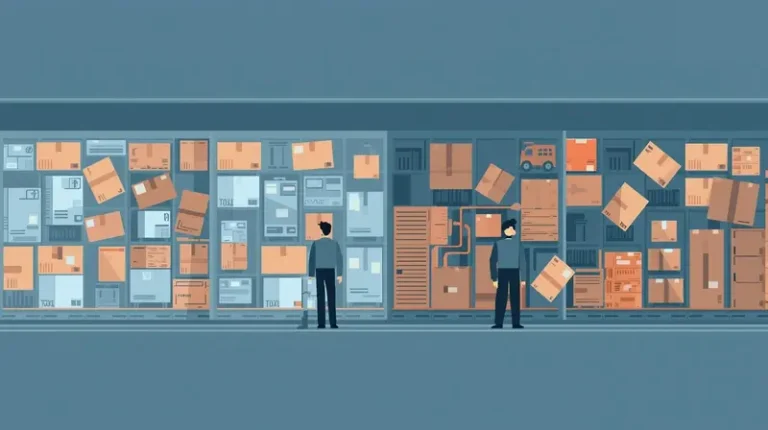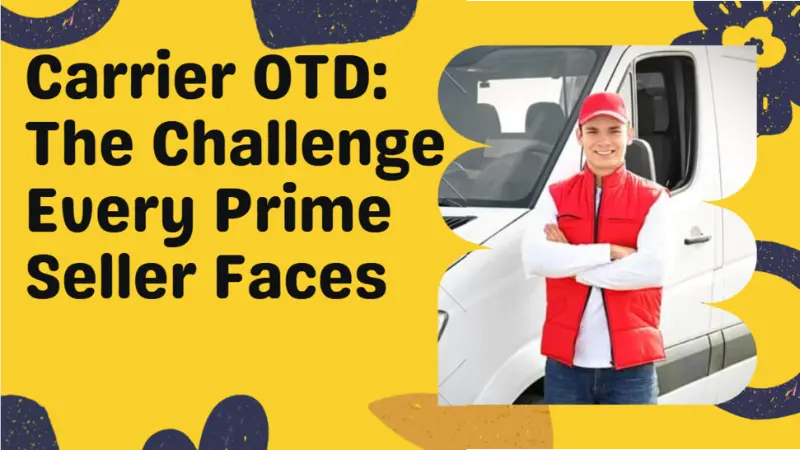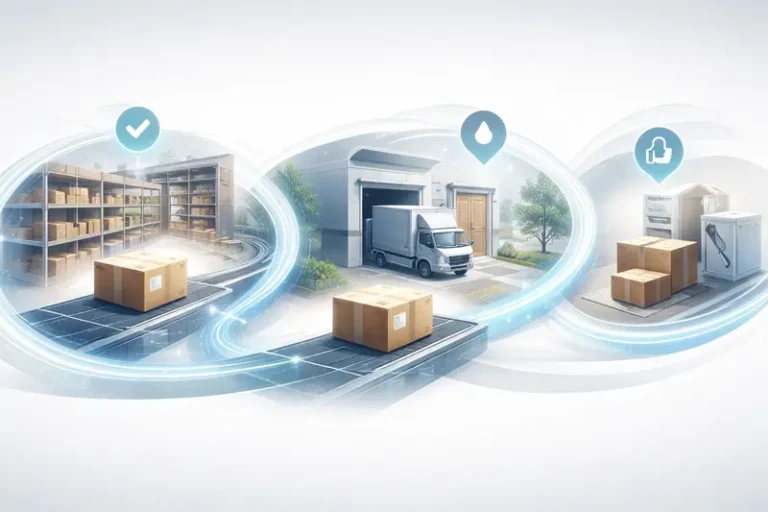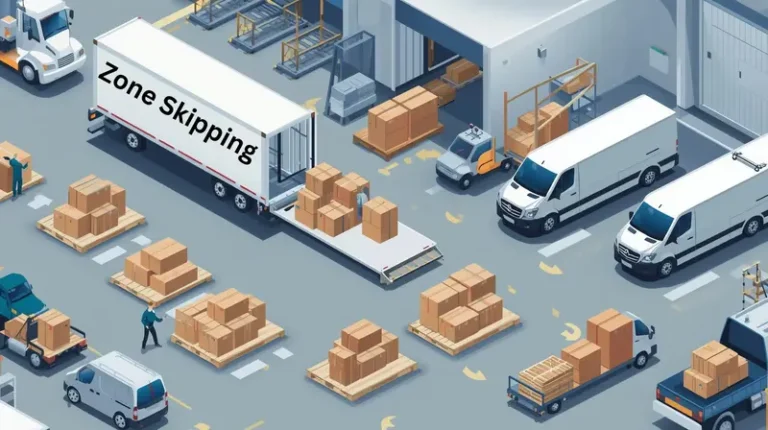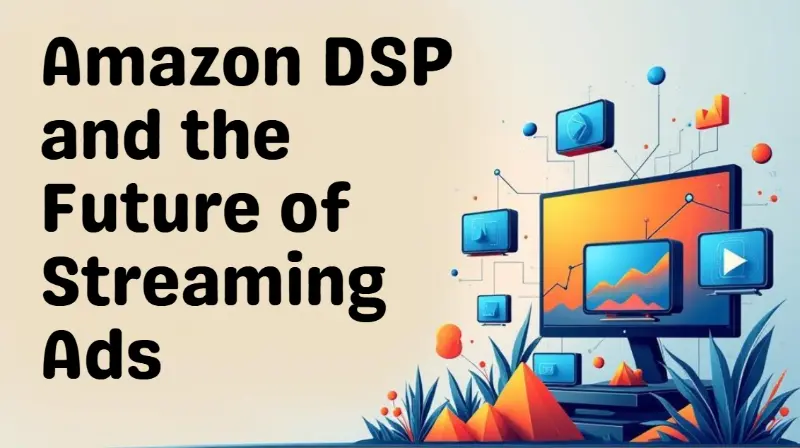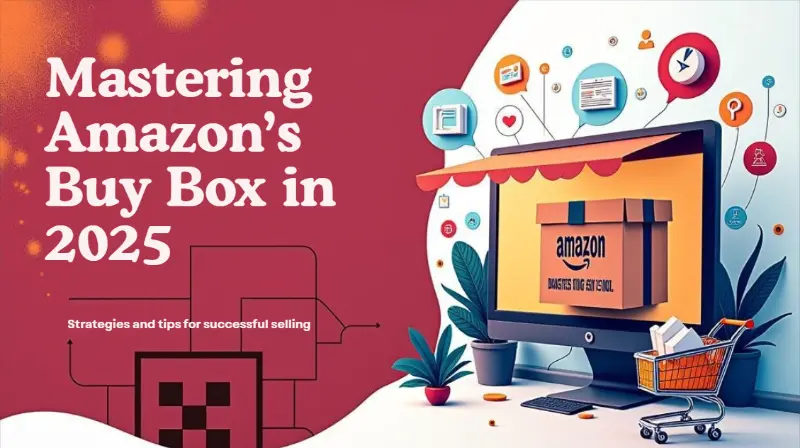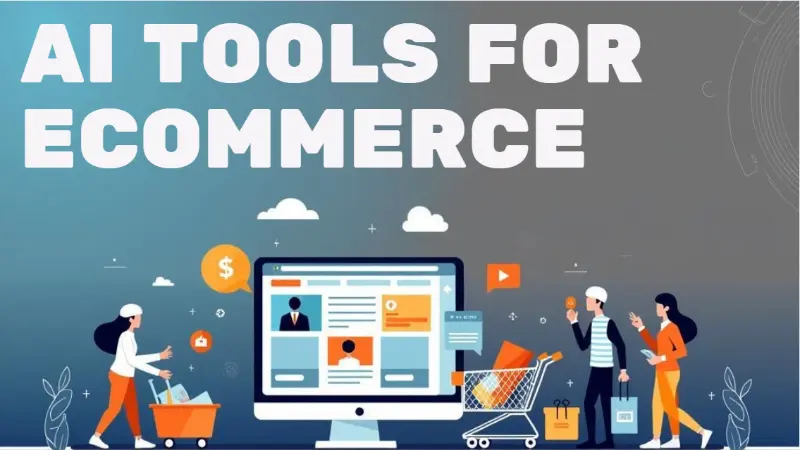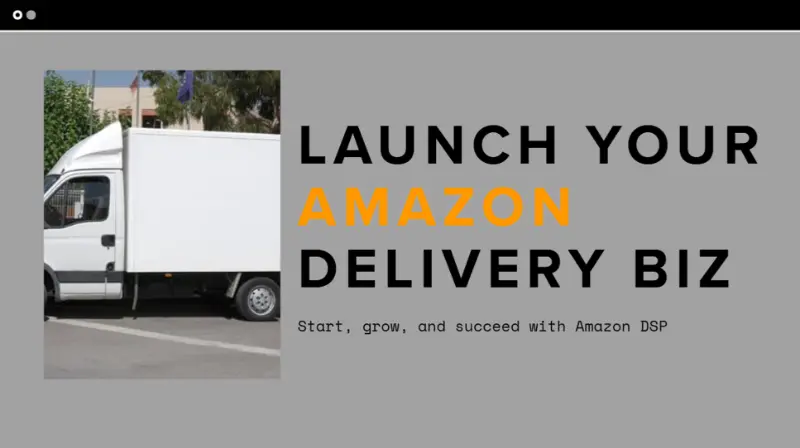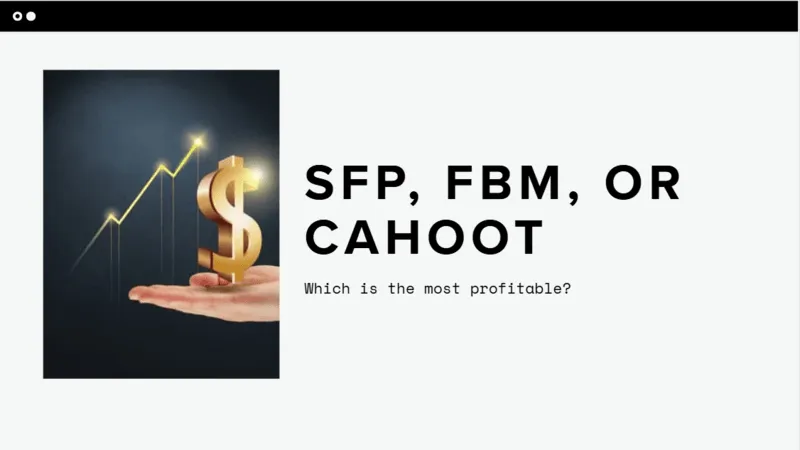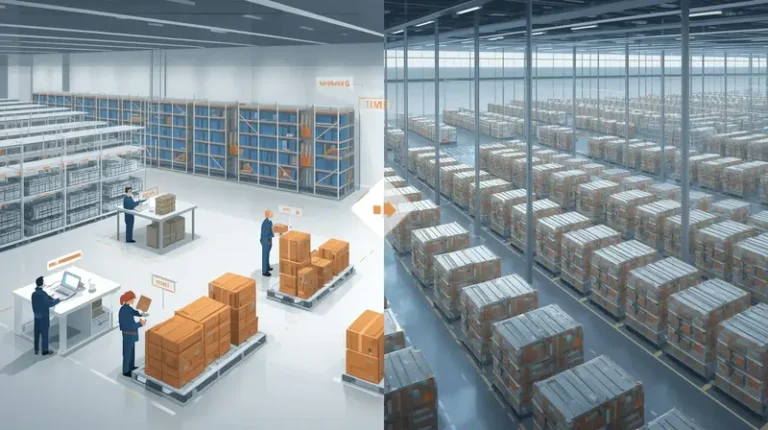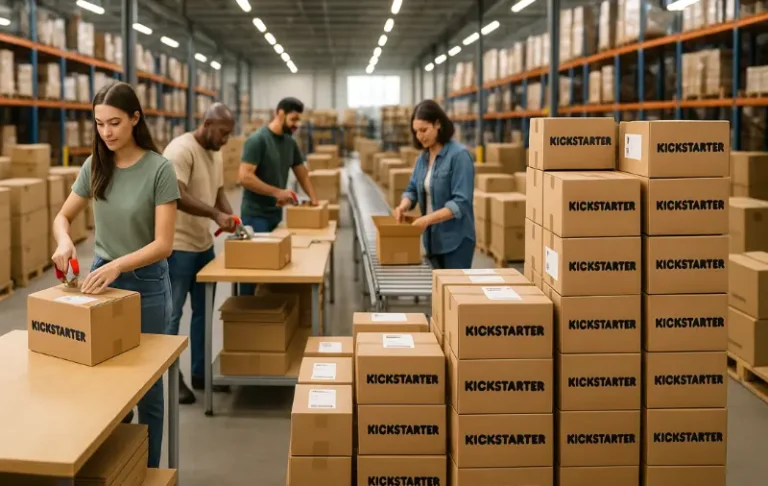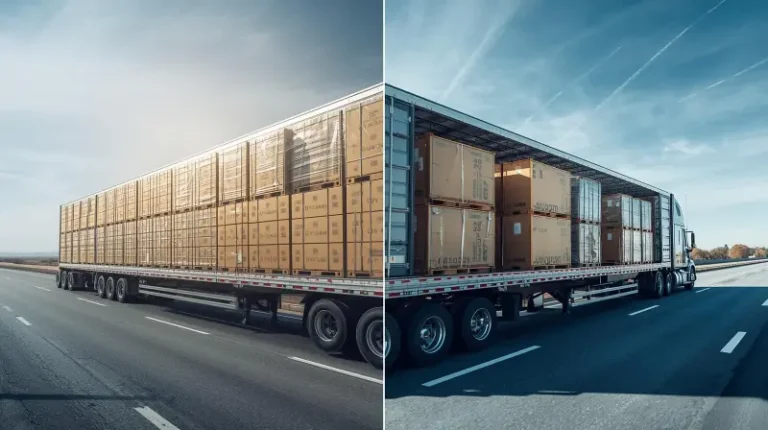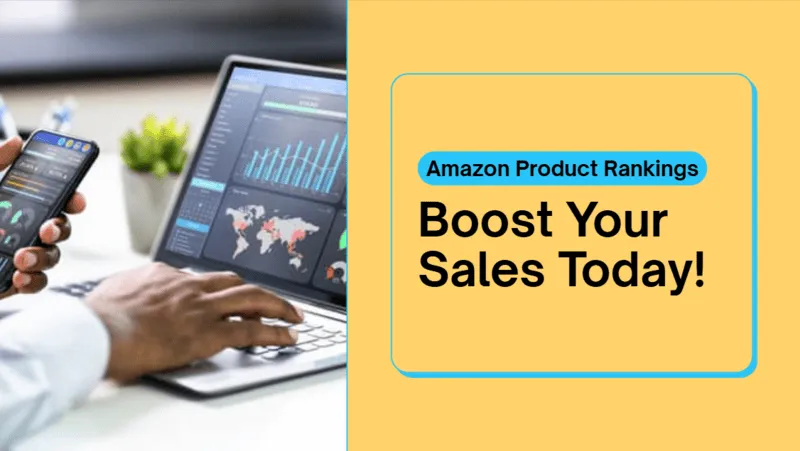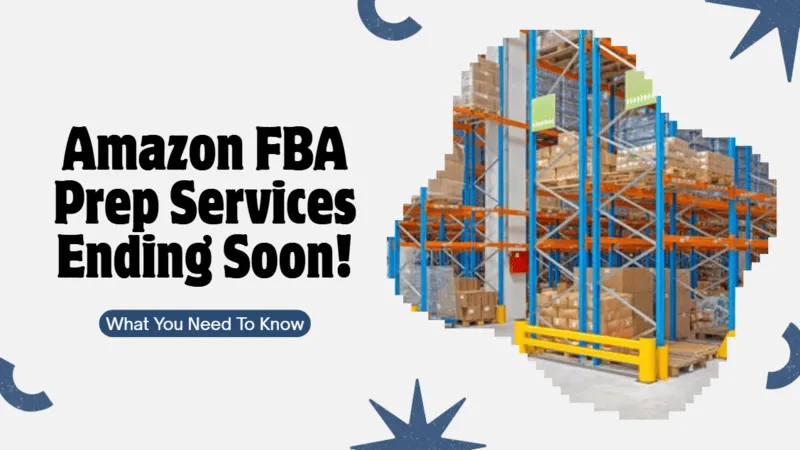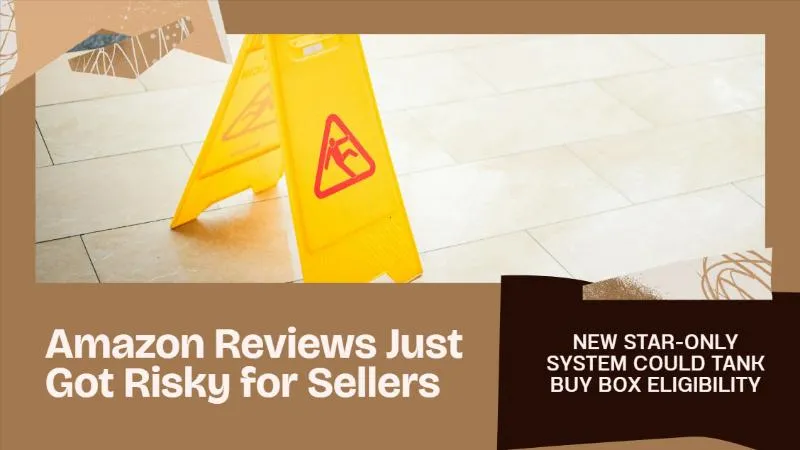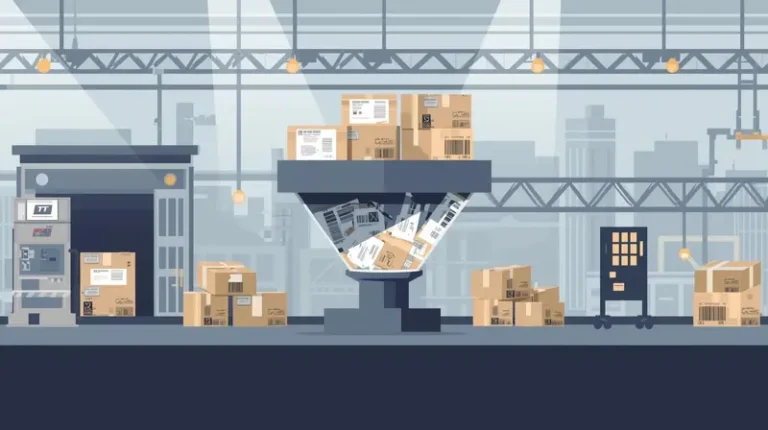Seller Fulfilled Prime vs FBA: The Inventory and Delivery Truth Amazon Doesn’t Fix
In this article
 4 minutes
4 minutes
- FBA’s Prime Delivery Problem: Inventory Placement Gaps
- SFP’s Strict Delivery Standards vs. FBA’s Flexibility
- Inbound Delays and Stockouts: FBA’s Unseen Time Cost
- Returns and Control: FBA’s Lenient Policies vs SFP’s Oversight
- Fee Surprises and Predictability: FBA’s Surcharges vs SFP’s Costs
- The Accountability Asymmetry: Convenience vs Control
- Frequently Asked Questions
Amazon’s Fulfillment by Amazon (FBA) promises Prime convenience, but when one fulfillment center runs out of stock, Prime delivery times can quietly stretch to 4 or 5 days – even if inventory is available elsewhere. In the debate of Seller Fulfilled Prime vs FBA, these are the two main fulfillment options for Amazon sellers, each shaping ecommerce merchants’ order fulfillment and shipping strategies. The uncomfortable truth is that Amazon does not routinely rebalance inventory across warehouses to preserve two-day Prime speeds. Meanwhile, Seller Fulfilled Prime (SFP) holds sellers to strict 1-day and 2-day delivery standards, highlighting a stark accountability asymmetry in how Prime shipping is achieved.
In this article, we’ll break down why FBA’s convenience often trades away control and reliability. We’ll examine how lack of dynamic inventory placement leads to regional Prime delays, how inbound receiving bottlenecks leave sellers waiting with no SLA, and how FBA’s lenient returns and unpredictable fees add hidden costs. By contrast, we’ll see how SFP’s demanding requirements can actually deliver more consistent Prime service through operational control and accountability. If you’re evaluating FBA vs SFP, understanding these differences will help you avoid costly mistakes and choose the fulfillment model that truly meets your delivery reliability and inventory control needs. Becoming an Amazon Prime seller and achieving Prime badge visibility can be a game changer for sales and customer trust.
FBA’s Prime Delivery Problem: Inventory Placement Gaps
Under FBA, Amazon decides where to store your products, and it does not actively redistribute your inventory solely to maintain fast Prime delivery nationwide. Your inventory is stored in Amazon’s fulfillment centers, and merchants incur storage fees for inventory stored there. This can lead to a critical weakness: if one region’s fulfillment center runs out of your item, Amazon won’t automatically move stock from elsewhere in time to cover demand. If inventory is stored too long, you may also face long-term storage penalties. Prime delivery speed quietly degrades, often showing 4–5 day delivery estimates instead of the expected two days.
Slash Your Fulfillment Costs by Up to 30%
Cut shipping expenses by 30% and boost profit with Cahoot's AI-optimized fulfillment services and modern tech —no overheads and no humans required!
I'm Interested in Saving Time and MoneyWhen One Fulfillment Center Runs Dry (Example)
To illustrate, imagine you sent 100 units to FBA and Amazon stored half in California and half in Illinois. If East Coast customers order after the Illinois stock sells out, orders ship from California – resulting in a 4 or 5-day “Prime” delivery timeframe for a New York buyer.
No Dynamic Rebalancing = Slow Prime in Some Regions
Amazon does not routinely rebalance inventory between fulfillment centers to preserve Prime delivery speeds. This means Prime members can receive slower delivery without seller penalties, often without sellers even realizing it.
SFP’s Strict Delivery Standards vs. FBA’s Flexibility
One of the biggest contrasts in Seller Fulfilled Prime vs FBA is how delivery performance is enforced. SFP sellers are held to exacting standards, while FBA listings can quietly slip to slower delivery times without seller consequences.
Prime Delivery SLAs: One-Day and Two-Day or Else
SFP sellers must meet strict on-time delivery, tracking, and cancellation thresholds or risk losing their Prime badge. Amazon enforces these standards weekly.
Inbound Delays and Stockouts: FBA’s Unseen Time Cost
FBA introduces upstream delays through unpredictable inbound receiving times. Sellers have no SLA and may wait weeks before inventory becomes available for sale.
Looking for a New 3PL? Start with this Free RFP Template
Cut weeks off your selection process. Avoid pitfalls. Get the only 3PL RFP checklist built for ecommerce brands, absolutely free.
Get My Free 3PL RFPSFP: Bypass the Check-In Queue
SFP bypasses Amazon’s receiving delays entirely. Inventory is available as soon as it’s on your shelf, giving sellers control and responsiveness.
Returns and Control: FBA’s Lenient Policies vs SFP’s Oversight
FBA’s return process prioritizes customer convenience, often at the seller’s expense. SFP gives sellers direct control and visibility into returns.
SFP: Hands-On Returns and Brand Protection
With SFP, returns come back to the seller, allowing inspection, recovery, and better brand protection.
Fee Surprises and Predictability: FBA’s Surcharges vs SFP’s Costs
FBA fees are complex and frequently change. SFP costs are more predictable and controllable, though operationally demanding.
The Accountability Asymmetry: Convenience vs Control
FBA offers convenience with less accountability. SFP demands accountability but grants control, predictability, and reliability.
Scale Faster with the World’s First Peer-to-Peer Fulfillment Network
Tap into a nationwide network of high-performance partner warehouses — expand capacity, cut shipping costs, and reach customers 1–2 days faster.
Explore Fulfillment NetworkFrequently Asked Questions
Does Amazon rebalance FBA inventory to preserve Prime speed?
No. Amazon does not routinely rebalance inventory between fulfillment centers to preserve two-day Prime delivery.

Turn Returns Into New Revenue
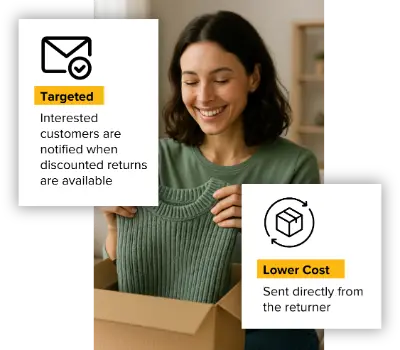
Your Seller Fulfilled Prime (SFP) Eligibility Depends On Your Carrier’s OTD Performance
In this article
 12 minutes
12 minutes
- Introduction to Amazon Seller Fulfilled Prime
- Enrollment and Eligibility
- What Changed in Amazon SFP
- The Carrier OTD Problem
- Why Sellers Can’t Just “Pick a Better Carrier”
- The Imbalance of Risk in SFP
- Merchant Fulfilled Network: The Backbone of SFP
- Strategies to Survive Carrier OTD Dependence
- Bigger Picture: Why This Matters Beyond Amazon
- Final Thoughts: The OTD Sword Hanging Over Sellers
- Frequently Asked Questions
Amazon has a cruel irony baked into Seller Fulfilled Prime (SFP). You can follow every rule, hit every ship-by deadline, and still lose your Prime badge. Why? Because SFP doesn’t ultimately measure you, it measures whether your carrier delivered on time. And if they don’t, you pay the price.
Amazon fulfillment includes both Fulfillment by Amazon (FBA) and Seller Fulfilled Prime (SFP), with SFP serving as an alternative to using Amazon’s fulfillment centers for order processing and shipping.
To understand how Seller Fulfilled Prime works, it’s important to know that Amazon sellers can choose between FBA and SFP, and third-party Amazon sellers play a key role in both programs. In SFP, sellers ship Prime orders directly from their own warehouse, provided they meet Amazon’s strict criteria for fast and reliable delivery.
Unlike Fulfillment by Amazon (FBA), where Amazon handles the entire fulfillment process, FBA sellers send inventory to Amazon’s fulfillment centers, where Amazon manages storage, picking, packing, and shipping. In SFP, the seller manages the fulfillment process themselves. This means that your performance metrics are directly tied to how well you and your chosen carrier execute each step.
Slash Your Fulfillment Costs by Up to 30%
Cut shipping expenses by 30% and boost profit with Cahoot's AI-optimized fulfillment services and modern tech —no overheads and no humans required!
I'm Interested in Saving Time and MoneyIntroduction to Amazon Seller Fulfilled Prime
Amazon Seller Fulfilled Prime (SFP) empowers third-party sellers to offer Prime shipping benefits directly from their own warehouses, without relying on Amazon’s fulfillment centers. By joining the seller fulfilled prime program, sellers can display the coveted Prime badge on their listings, signaling fast and free shipping to millions of Prime customers. This not only boosts visibility but also helps sellers gain access to Amazon’s loyal customer base and expand their sales channels.
To qualify for Amazon Seller Fulfilled Prime, sellers must meet strict criteria that reflect Prime customers’ expectations, such as rapid shipping, high order accuracy, and exceptional customer satisfaction. SFP sellers are responsible for managing their own fulfillment process, including inventory management and shipping, to ensure every Prime order meets Amazon’s high standards. Sellers who successfully complete the SFP trial period and maintain Prime status can enjoy increased sales, improved customer trust, and a stronger presence in the competitive Amazon marketplace. For many online businesses, Seller Fulfilled Prime offers a unique opportunity to control their fulfillment process while reaping the benefits of the Prime program.
Enrollment and Eligibility
Enrolling in the Seller Fulfilled Prime program requires careful preparation and a commitment to meeting Amazon’s demanding standards. To get started, sellers must have a professional selling account and a default shipping address within the United States. Once these prerequisites are met, sellers can configure their shipping settings in Seller Central to enable Prime shipping and ensure their offers reflect Prime customers’ expectations for speed and reliability.
During the SFP Trial Period, sellers must demonstrate their ability to consistently meet Amazon’s minimum performance requirements, including on-time delivery, valid tracking, and fast shipping speeds. Maintaining a high level of customer service and meeting Prime requirements is essential for keeping Prime status and avoiding removal from the program. Sellers should regularly review their shipping settings and monitor performance metrics to ensure they continue to meet the standards of the Seller Fulfilled Prime Program. By understanding and preparing for these requirements, sellers can position themselves for success and provide an outstanding experience to Prime customers.
What Changed in Amazon SFP
Amazon recently tightened the screws on SFP with updated rules:
- 93.5% weekly On-Time Delivery Rate (OTD) across all SFP orders
- 100 minimum shipments per month to even qualify
- Strict one- and two-day delivery promises across 48 states
- Minimum Product Detail Page Views by product size tier
- ≤ 0.5% Pre-fulfillment Cancellation Rate tracking Seller-cancelled orders
These rules represent the minimum performance requirements that sellers must meet and maintain to qualify for and retain the Prime badge. Maintaining prime status once eligibility is achieved is essential to ensuring you keep the Prime badge and all the associated benefits for your Prime listings.
If you fall short, even by a sliver, your Prime badge disappears until you claw back up. If you do not meet the requirements, the Prime badge displayed on your Prime listings and Prime items will be removed, significantly impacting your product visibility and sales. It’s no longer about doing “most” things right. It’s about perfection. But here’s the twist: perfection isn’t even in your hands.
The Carrier OTD Problem
Carriers control the final leg of delivery, and Amazon grades you on their performance. SFP sellers must ensure fast shipping speed and nationwide delivery coverage to meet Amazon’s requirements, which adds significant logistical complexity. You can hand off a package on time, scan it into the network, and still get burned if the carrier misses its truck cutoff, misroutes at a sortation center, or has a weather delay.
For sellers, this feels rigged. You’re being measured on someone else’s reliability. And unlike FBA, where Amazon absorbs the risk, (and doesn’t ding itself for late deliveries), SFP makes your business hostage to the carrier’s OTD. Many sellers use Amazon Buy Shipping services to purchase shipping labels, manage shipments, and track deliveries through Amazon’s approved carrier network, but you are still responsible for the final delivery metrics.
Imagine running 1,000 SFP shipments in a month. You hit 100% On-time Shipment. But UPS or FedEx delivers 60 late. That’s a 93.9% OTD, barely scraping the requirement. If they miss 70? You’re at 93.0%. Badge gone. Sales crater.
Looking for a New 3PL? Start with this Free RFP Template
Cut weeks off your selection process. Avoid pitfalls. Get the only 3PL RFP checklist built for ecommerce brands, absolutely free.
Get My Free 3PL RFPWhy Sellers Can’t Just “Pick a Better Carrier”
Some might say: use better carriers. But Amazon’s OTD system doesn’t care about nuance. Even the best carriers have bad weeks. Peak season surges, labor strikes, and regional weather, these events sink OTD performance fast.
Carriers are incentivized to protect their own high-volume clients, not your handful of SFP parcels. And regional carriers often can’t cover Amazon’s two-day footprint. To participate in SFP, you must assign your SKUs to a prime shipping template within Seller Central, which enables your products for Prime shipping. That leaves you with UPS, FedEx, or USPS, and each has blind spots Amazon Shipping is rolling out as a 4th option in many regions, but it has its own limitations.
A flexible prime strategy is essential to adapt to carrier performance and ongoing delivery challenges.
The Imbalance of Risk in SFP
Amazon frames SFP as freedom: control your inventory, keep FBA fees at bay, win the Buy Box. SFP also allows sellers to manage their own storage space, potentially reducing overhead costs compared to FBA. But the risk transfer is brutal. You carry the cost of fast shipping and the accountability for late deliveries you didn’t cause. These fast shipping costs can significantly impact your profit margins, making it vital to carefully calculate all expenses to ensure your business remains profitable.
This is why SFP feels unsustainable for many sellers. You’re punished for variables beyond your control, while Amazon shields itself from customer disappointment by pointing to you.
Merchant Fulfilled Network: The Backbone of SFP
The Merchant Fulfilled Network (MFN) serves as the foundation of the Seller Fulfilled Prime program, allowing sellers to fulfill Prime orders directly from their own warehouse while maintaining control over the entire fulfillment process. Through MFN, sellers can leverage Amazon’s shipping services, such as Amazon Buy Shipping, to purchase shipping labels, track shipments, and ensure fast and free shipping for Prime customers. Sellers who want to fulfill orders from channels other than Amazon can consider Amazon Multi-Channel Fulfillment (MCF), which allows the use of Amazon logistics across diverse ecommerce platforms.
Participating in the merchant fulfilled network requires robust inventory management, reliable fulfillment capacity, and a commitment to meeting Amazon’s strict performance standards. Sellers must carefully manage shipping costs, maintain inventory visibility, and ensure their fulfillment process can handle the demands of Prime orders. By optimizing their fulfillment operations and leveraging the flexibility of MFN, sellers can expand their online business, fulfill orders efficiently, and maintain a competitive edge in the Prime program. However, success in SFP depends on the ability to balance fulfillment costs, meet customer expectations, and consistently deliver a Prime-worthy experience.
Strategies to Survive Carrier OTD Dependence
So how do you navigate this trap? There are a few imperfect strategies. First, evaluate different fulfillment options, such as SFP, FBA, and third-party logistics providers, to determine which best optimizes your delivery performance and meets Amazon’s requirements. Having a clear prime strategy is essential for optimizing your participation in Seller Fulfilled Prime, as it allows for continuous adjustments to meet Amazon’s evolving standards.
- Spread Volume Across Carriers: Don’t let a single carrier’s bad week wipe out your badge. Split shipments where it makes sense.
- Build Weekly Monitoring, Not Monthly: Amazon now enforces OTD weekly. Track performance in real-time, not at the end of the month.
- Negotiate Carrier SLAs (Good Luck): Some enterprise-level sellers can hold carriers to OTD service guarantees. But for most, leverage is thin.
- Use Third-Party Tools and Networks: Automated routing, peer-to-peer fulfillment, or SFP-optimized 3PLs can spread risk across regions and carriers. Selecting a reliable fulfillment partner is crucial to consistently meet Amazon’s strict delivery standards and maintain Prime eligibility.
- Maintain FBA as a Safety Valve: For high-stakes SKUs, keep backup inventory in FBA. Effective inventory management is essential when balancing stock between FBA and SFP to ensure Prime eligibility and avoid stockouts. Planning for seasonal demand is also critical to ensure product availability during peak periods and to optimize storage and shipping costs. Losing Prime visibility can crush sales overnight.
Participating in Seller Fulfilled Prime allows you to create seller fulfilled prime offers, giving you the advantage of maintaining the Prime Badge and offering fast, free shipping while managing your own fulfillment. As an SFP seller, you are responsible for meeting strict performance requirements, but you also gain greater control over your fulfillment process and can benefit from increased competitiveness in the marketplace.
Scale Faster with the World’s First Peer-to-Peer Fulfillment Network
Tap into a nationwide network of high-performance partner warehouses — expand capacity, cut shipping costs, and reach customers 1–2 days faster.
Explore Fulfillment NetworkBigger Picture: Why This Matters Beyond Amazon
This isn’t just about SFP. It’s a warning shot for ecommerce operators everywhere. As marketplaces push more accountability onto sellers, the margin for error shrinks. These challenges are highly relevant for anyone running an online business, especially third-party Amazon sellers, as fulfillment and logistics are critical to supporting growth and customer satisfaction.
The lesson: logistics performance is becoming a brand asset. Customers don’t see UPS or FedEx on the box. They see you. And if their package is late, they’ll blame you, not the carrier, not Amazon. Effectively managing customer service inquiries is also essential to maintain customer satisfaction and control over the sales process.
In other words: the weakest link in your supply chain isn’t optional. It’s existential. The competitive landscape for ecommerce is becoming more challenging as marketplaces continue to raise performance expectations.
Final Thoughts: The OTD Sword Hanging Over Sellers
Amazon has built SFP into an almost impossible standard. Sellers who want the Prime badge must first complete a Prime trial period, a 30-day window where they must meet strict Prime performance and shipping requirements to qualify for SFP. Even after qualifying, maintaining prime status is an ongoing challenge, as sellers must consistently adhere to Amazon’s high standards and performance metrics to retain the Prime badge. That’s not partnership, it’s risk transfer disguised as opportunity.
So the real question for sellers isn’t: can you hit the SFP metrics? It’s: can your carrier? And if not, what’s your Plan B when Amazon yanks your badge?
Frequently Asked Questions
What is the On-Time Delivery Rate (OTD) for SFP?
Amazon requires a 93.5% weekly OTD for all SFP shipments. Sellers must also maintain a low cancellation rate, specifically less than 0.5%, as high cancellation rates can jeopardize their Prime badge. This means carriers must successfully deliver nearly every package on time for sellers to keep their Prime badge.
How does Amazon calculate OTD for SFP?
Amazon tracks the promised delivery date vs. the carrier’s actual delivery scan. Even if you ship on time, the score reflects the carrier’s performance, not yours.
Can weather or carrier errors still hurt my SFP metrics?
Yes. Amazon doesn’t adjust for weather delays, misrouted packages, or carrier staffing shortages. Sellers are penalized for factors outside their control. Though more recently, Amazon announced that it, in its sole discretion, would exempt late deliveries due to weather conditions where they can verify that weather impacted carrier networks in a region. No Support Ticket necessary. But we’ve yet to see this in practice.
What happens if I miss the SFP OTD requirement?
If your OTD falls below the threshold, Amazon suspends your Prime badge. This usually results in an immediate drop in Buy Box wins and sales volume. Sellers must start over in the SFP Trial if they wish to re-attempt eligibility.
How can sellers protect themselves from OTD failures?
Options include diversifying carriers, tracking OTD performance weekly, using 3PLs with multi-carrier capacity, and keeping FBA inventory as a fallback for critical products.
Sellers should regularly monitor their performance metrics and manage SFP settings within Seller Central. Amazon Seller Central provides the most up-to-date information on SFP requirements and performance. To ensure you meet Prime delivery promises, configure shipping settings in Seller Central according to Amazon’s guidelines. Regularly reviewing and updating your shipping settings is essential to maintain Prime eligibility and optimize delivery performance.

Turn Returns Into New Revenue

Amazon Demand-Side Platform (DSP): The Future of Streaming TV and Digital Ads
I didn’t expect to wake up one day and think, “Wow, Amazon’s DSP is about to rewrite the ad playbook.” But here we are. As part of the broader Amazon Advertising ecosystem, Amazon’s Demand-Side Platform (DSP) is pulling ahead in a big way. Amazon’s Demand-Side Platform offers advanced, data-driven capabilities for targeted advertising, accessible to all advertisers. Amazon DSP stands out in the digital advertising landscape for its integration with Amazon’s data and its unique ability to reach audiences both on and off Amazon platforms.
Snapshot For Busy Brands
Amazon DSP ads aren’t just another channel; they’re a full-stack programmatic hub that lets you buy ad inventory across multiple platforms, including Amazon-owned properties and beyond. Think Prime Video, Fire TV, Amazon owned sites, Amazon owned websites, third party websites, audio, mobile apps, even CTV via Roku, as well as Amazon devices, all with Amazon’s data-rich targeting under the hood.
Amazon DSP offers a variety of ad formats and ad types, such as display, video, and audio ads, to reach customers at different stages of the journey. The platform provides access to premium ad placements and valuable ad space within a digital marketplace, maximizing your campaign’s reach and effectiveness. And ad spend on this thing is exploding.
Slash Your Fulfillment Costs by Up to 30%
Cut shipping expenses by 30% and boost profit with Cahoot's AI-optimized fulfillment services and modern tech —no overheads and no humans required!
I'm Interested in Saving Time and MoneyWhy Amazon’s DSP Is Surging
Let’s talk numbers: Amazon’s Q2 2025 advertising revenue hit $15.7 billion, a 22 percent year-over-year jump, far outpacing its core retail growth. Ad campaigns run through Amazon DSP have significantly contributed to this increase in ad revenue. Executives specifically credited DSP improvements and a new Roku-connected TV deal as major catalysts, noting measurable gains in campaign performance through enhanced targeting and reporting.
Early signs already show advertisers are doubling down. Prime Video ad buys made via DSP rose from 26 percent in Q3 2024 to 36 percent in Q4, and by late 2024, Amazon DSP accounted for 32 percent of all Amazon ad spend. Setting an appropriate marketing budget is crucial for Amazon DSP campaigns, as a minimum spend is often required to fully leverage its capabilities. For advertisers, new to brand sales have become a key metric when evaluating the impact of Prime Video ad buys through Amazon DSP.
Let me put it bluntly: Amazon is turning DSP into its playbook, for video, audio, programmatic display, streaming TV ads, you name it. Amazon DSP campaigns are now central to this shift. It’s cheaper on fees. It leans on unmatched first-party data. And it’s becoming the default for advertisers who want those data-driven, performance-rich hooks.
How Amazon DSP Works, And Where Your Ads Can Show Up
At its core, Amazon DSP is a tool for buying ad inventory through programmatic real-time bidding (RTB), same as other DSPs. This is a form of programmatic advertising that leverages ad exchanges and ad servers to automate and optimize the process of buying and selling digital ads. But it’s the panoramic advantage that matters:
- You can target based on Amazon’s shopper behaviors, purchase history, browsing intent, and even the detailed aisles they’ve wandered through. Amazon DSP enables advertisers to reach target audiences, relevant audiences, and existing audiences using advanced ad tech for precise segmentation and campaign optimization.
- Your ads appear across Amazon’s ecosystem, Prime Video, product detail pages, Fire TV, mobile browsers, and now across the open web via Amazon Publisher Services and other ad exchanges. This includes Amazon DSP inventory and a variety of ad products such as online video ads, audio ads, and sponsored display ads. Ad placements can be purchased through private marketplace deals and real-time bidding, allowing you to purchase ads and purchase ad inventory efficiently.
- The recent Roku integration means you can now reach over 80 million U.S. households using connected TVs via Roku and Fire TV, falling into Amazon’s DSP matrix. Available inventory also includes video content, audio ads, Amazon Music, IMDb TV, and STV ads, expanding your reach across streaming and audio platforms.
You can measure ad effectiveness using metrics like detail page view rate (DPVR), which shows how well your ads drive users to a product detail page or your own website via web browsers. Sponsored display, sponsored display ads, sponsored brands, and sponsored ads are also available within Amazon’s ecosystem, providing additional options for campaign strategy.
Bonus: Amazon’s Multi-Touch Attribution, just deployed, blends A/B tests with machine learning so you can see exactly which ad touchpoint nudged a shopper. That’s next-level measurement. Amazon Marketing Cloud and Amazon’s store provide advanced analytics, reporting, and shopping data to further inform your campaign decisions.
Whether your goal is to sell products or convert shoppers, Amazon DSP leverages purchase intent to help you reach the right ads at the right time. You can choose between managed service, where Amazon or a partner manages your campaigns, or self service, which allows you to control and optimize campaigns independently.
Looking for a New 3PL? Start with this Free RFP Template
Cut weeks off your selection process. Avoid pitfalls. Get the only 3PL RFP checklist built for ecommerce brands, absolutely free.
Get My Free 3PL RFPGood News, Bad News, For Competitors
This isn’t happening in a vacuum. The Trade Desk (a big independent DSP) just took a historic 38 – 40 percent stock dip. Analysts were scared, this isn’t just earnings jitters, this is Amazon eating into CTV ad budgets, margins, and mindshare. Compared to other demand side platforms in the digital advertising space, The Trade Desk stands out for its independence and broad inventory access, but Amazon DSP’s unique integration and data advantages are shifting the landscape.
MoffettNathanson lowered TTD’s stock rating, explicitly citing Amazon DSP’s rise and the way it locks brands into its system, “the Amazon shadow… front and center.”
But, to be fair, Trade Desk hasn’t folded. Advertisers still lean on TTD for cross-channel reach, outside Amazon’s walled gardens. DSP budgets are often additive, not always siphoned off. And deep reporting and independence still matter, even as these shifts reshape the broader digital advertising ecosystem.
What This Means For Ecommerce And Retail Media Teams
Here’s where I make it practical:
Amazon DSP can transform your overall advertising strategy by enabling advanced targeting, measurement, and optimization across a wide range of ad products and inventory sources.
1. If you’re already advertising on Amazon, add DSP now. It’s where off-search, high-intent Amazon audiences live, and you can leverage a variety of ad products to reach and convert shoppers.
2. Want to run streaming TV ads? Amazon DSP with Roku gets you into lean-back moments, impressions that weren’t accessible a year ago. Choose the right ad types, ad formats, and ad placements to optimize your ad campaigns and reach your audience at every stage of the customer journey.
3. Lean on first-party data. DSP is built to use Amazon’s shopper behavior to laser-target people before they search for your next product. Use this data to deliver the right ads to the right audience, target purchase intent, and ultimately sell products more effectively.
4. Measure smarter. Use the new Multi-Touch Attribution to see what actually influenced the conversion, not just clicks. Track campaign performance closely to optimize results and enhance your advertising strategy.
5. Still value open-web reach? Bucket part of your budget away from DSP to independent DSPs like Trade Desk, but be smart about the split and performance layering.
Why This Matters
Amazon’s stacking ad inventory across its own sites, streaming platforms, and broad third-party placements is redefining where marketers spend digital ad dollars. Amazon is consolidating ad space and ad placements across its digital marketplace, streamlining how advertisers access and manage inventory. This shift is also impacting ad revenue for brands and agencies, as the new buying environment changes how returns are measured and optimized. For ecommerce brands, that means controlled shopping-inspired ad journeys. Agencies? It’s a giant shift in media buying workflows, with ad tech integration and a growing variety of ad products now available to support campaign management and targeting.
Whether DSP ends up dominating or just co-dominating, one thing’s clear: if you don’t fit into Amazon’s programmatic picture, you’re invisible to a growing share of the market.
Scale Faster with the World’s First Peer-to-Peer Fulfillment Network
Tap into a nationwide network of high-performance partner warehouses — expand capacity, cut shipping costs, and reach customers 1–2 days faster.
Explore Fulfillment NetworkFinal Thoughts
I’ve been watching Amazon’s DSP evolve for years, but this moment feels different. With recent gains in inventory access, better measurement tools, and sky-high ad growth, it’s no longer a fringe play; it’s core infrastructure for streaming TV ads, video, audio, and beyond.
Marketers who tap into DSP now, leveraging Amazon’s reach and data, while still balancing open-web strategies, are the ones reshaping how commerce and advertising converge in 2025.
Frequently Asked Questions
How does Amazon DSP differ from traditional Amazon ads?
Amazon DSP buys ad inventory via programmatic RTB (Real-Time Bidding) across Amazon’s ecosystem, and beyond, using audience data tied to real shopper behaviors.
Can I run streaming TV ads through Amazon DSP?
Yes. With partnerships like Roku and Fire TV, DSP now includes CTV placements across major streaming platforms.
What makes Amazon DSP competitive versus other DSPs?
Its access to first-party shopper data, exclusive inventory, competitive pricing, and enhanced attribution (like Multi-Touch Attribution) give it a performance edge.
Is The Trade Desk sinking because of Amazon DSP?
Trade Desk took a significant hit, analysts flagged Amazon DSP as a key threat. But many advertisers still value Trade Desk’s open-web reach and neutrality.
How should I allocate ad budget between Amazon DSP and independent DSPs?
Lean into DSP for Amazon-owned and streaming inventory, while reserving part of your budget for independent DSPs to maintain open-web presence and measurement balance.

Turn Returns Into New Revenue

Amazon Buy Box 2025 Update: New Rules and Strategies for Sellers
The Amazon Buy Box is the most valuable piece of digital real estate in ecommerce. More than 80% of Amazon sales happen through it, and for mobile purchases, the percentage is even higher. In 2025, winning the Buy Box isn’t just about the lowest price. Amazon’s algorithm weighs dozens of factors, from fulfillment method to seller performance, to determine which seller earns that coveted position.
For ecommerce businesses, understanding the latest Buy Box algorithm changes is no longer optional. Without Buy Box eligible status, sales stall. With it, sellers can boost sales, increase conversion rates, and gain credibility with Amazon shoppers. This guide breaks down what’s changed in 2025, what drives eligibility, and the exact strategies sellers need to master to stay competitive.
Slash Your Fulfillment Costs by Up to 30%
Cut shipping expenses by 30% and boost profit with Cahoot's AI-optimized fulfillment services and modern tech —no overheads and no humans required!
I'm Interested in Saving Time and MoneyWhy the Buy Box Matters More Than Ever
The Buy Box sits on every product detail page, presenting customers with the default “Add to Cart” or “Buy Now” option. For many sellers, it’s the single biggest driver of sales volume.
When your product listing is suppressed from the Buy Box, customers have to click “See All Buying Options” to find you, a step most shoppers won’t take. This is why a suppressed Buy Box can slash sales overnight.
In 2025, Amazon tightened its eligibility rules. Sellers need a professional seller account, consistent on-time shipping, valid tracking rates, and low negative feedback rates. Failing any of these metrics can push a seller out of eligibility, regardless of how competitive their price is.
Key Factors in the Amazon Buy Box Algorithm
Amazon’s Buy Box algorithm is a black box, but seller data and platform updates reveal what matters most. Here are the key factors that determine who wins:
1. Pricing Strategy
The Buy Box isn’t always about the absolute lowest price. Amazon calculates the landed price (product price plus shipping) and considers competitive external price benchmarks. If your price is significantly higher than on other sites, you risk Buy Box suppression. At the same time, pricing wars can erode profit margins, so balancing competitive pricing with sustainable margins is essential.
2. Fulfillment Method
FBA sellers (Fulfilled by Amazon) often have a natural advantage because Amazon controls shipping speed, tracking accuracy, and customer service. However, high-performance FBM sellers who provide fast shipping, accurate delivery dates, and excellent customer service can still compete effectively.
3. Seller Performance Metrics
Metrics like valid tracking rate, on-time delivery, order defect rate, and negative feedback rate directly influence Buy Box eligibility. Sellers with consistently high ratings and responsive customer service outperform those who cut corners.
4. Inventory Availability
Stockouts or inaccurate inventory updates hurt Buy Box performance. Amazon rewards sellers who keep items in stock and update their inventory tab accurately.
5. Customer Experience
From seller response time to packaging quality, customer experience is an increasingly important factor. Amazon prioritizes sellers who can notify customers quickly, resolve issues, and provide reliable delivery.
Looking for a New 3PL? Start with this Free RFP Template
Cut weeks off your selection process. Avoid pitfalls. Get the only 3PL RFP checklist built for ecommerce brands, absolutely free.
Get My Free 3PL RFPWhat Changed in 2025?
Amazon introduced several updates that shifted Buy Box dynamics:
- Greater emphasis on customer feedback: The Buy Box algorithm now more heavily weights customer satisfaction, including positive feedback count and quick resolution of customer interactions.
- Suppressed Buy Box expansion: More listings now face suppressed Buy Boxes if Amazon deems pricing unfair compared to external sites.
- Fulfillment flexibility: Amazon has slightly opened the door for FBM sellers with excellent seller metrics, creating more opportunities for high-volume sellers outside FBA.
- Box rotations across sellers: Instead of a single seller dominating, Amazon rotates Buy Box winners more often when multiple sellers have similar metrics.
For ecommerce businesses, these changes make consistent seller performance and accurate pricing strategies even more critical.
Strategies to Win the Buy Box in 2025
1. Master Competitive Pricing
Use automated repricing tools to stay aligned with Amazon’s Buy Box algorithm. Avoid lowest price point manipulations that risk suppression. Instead, monitor competitive external prices and adjust dynamically.
2. Optimize Fulfillment
FBA remains the easiest route to eligibility, but FBM sellers can win with accurate shipping dates, fast delivery, and valid tracking rates. Offering multiple shipping options also helps.
3. Improve Seller Metrics
Seller performance is a long game. Focus on maintaining low negative feedback rates, improving customer response times, and hitting on-time shipping targets. High-performance sellers gain a competitive edge, even in saturated categories.
4. Manage Inventory Proactively
Ensure inventory availability across your store. Use detailed analytics and predictive tools to track sales volume, forecast demand, and avoid stockouts.
5. Enhance Customer Experience
Proactively engage customers, provide accurate shipping notifications, and resolve complaints quickly. Customer satisfaction and loyalty directly influence your eligibility.
The Risk of Pricing Wars
A common mistake sellers make is entering unsustainable pricing wars. While lowering prices may temporarily win the Buy Box, it often leads to suppressed profit margins and increased risk of account health issues. Instead, sellers should use pricing strategies that balance competitiveness with profitability.
Professional sellers who monitor profit margins alongside Amazon sales volume will have a long-term advantage over those focused only on price points.
Scale Faster with the World’s First Peer-to-Peer Fulfillment Network
Tap into a nationwide network of high-performance partner warehouses — expand capacity, cut shipping costs, and reach customers 1–2 days faster.
Explore Fulfillment NetworkBeyond the Buy Box: Driving Sales in 2025
Winning the Buy Box is critical, but it’s not the only way to increase sales. Amazon’s white box (when the Buy Box is suppressed but Amazon still displays a “See Buying Options” button) can still generate revenue if you have strong product listings, positive customer reviews, and competitive shipping.
Ecommerce businesses should also focus on:
- Improving product listings with SEO optimized content and accurate product descriptions.
- Running marketing campaigns that drive external traffic to Amazon.
- Using detailed analytics to evaluate performance and adjust strategies in real time.
Conclusion
In 2025, the Amazon Buy Box is harder to win but more valuable than ever. Sellers must balance pricing strategies, fulfillment methods, and seller performance metrics while avoiding suppressed Buy Box penalties.
For ecommerce businesses, the path forward is clear: adopt data-driven decisions, focus on customer experience, and implement strategies that drive long-term sales growth. The sellers who thrive will be those who master the Buy Box algorithm without falling into the trap of endless pricing wars.
Frequently Asked Questions
What does it mean to be Buy Box eligible?
Buy Box eligibility means a seller meets Amazon’s minimum standards for performance metrics, shipping reliability, and professional seller account status. Without eligibility, you cannot win the Buy Box.
How does pricing affect the Buy Box?
Amazon considers landed price and competitive external price benchmarks. While the lowest price can help, unsustainably low pricing or mismatched prices across platforms can suppress the Buy Box entirely.
Can FBM sellers win the Buy Box?
Yes. While FBA sellers often have an advantage, FBM sellers with fast shipping, valid tracking, and excellent customer feedback can still win.
Why is my Buy Box suppressed?
Common reasons include unfair pricing compared to other platforms, poor seller performance metrics, or inventory stockouts. Suppressed Buy Box status means customers won’t see your listing as the default purchase option.
How can I improve my chances of winning the Buy Box?
Maintain strong seller metrics, use automated pricing tools, ensure inventory availability, and provide excellent customer service. Combining these strategies with a competitive fulfillment method gives you the best chance to win.

Turn Returns Into New Revenue

AI Tools for Ecommerce: Choosing the Right Tech to Stay Competitive
In this article
 6 minutes
6 minutes
- Why AI in Ecommerce Is No Longer Optional
- The Power of Data in Ecommerce
- Key Areas Where AI Tools Drive Impact
- Evaluating the Right AI Tools for Ecommerce
- Adoption Challenges: Data Quality and Trust
- The Future: Generative AI in Ecommerce
- Why Adoption Matters More Than Experimentation
- Conclusion
- Frequently Asked Questions
Why AI in Ecommerce Is No Longer Optional
AI has become the hidden engine driving the ecommerce industry. From automated inventory management to personalized recommendations, AI tools for ecommerce are reshaping how online businesses operate. Walmart, Amazon, and Shopify have already made AI a core part of their strategies, which means independent ecommerce businesses need to adopt the right AI technology, or risk falling behind.
AI tools are no longer a futuristic add-on; they are essential for analyzing customer data, predicting demand, improving customer satisfaction, and staying competitive in a market dominated by giants. Sellers who fail to implement AI-powered solutions will find themselves reacting to market trends rather than shaping them.
Slash Your Fulfillment Costs by Up to 30%
Cut shipping expenses by 30% and boost profit with Cahoot's AI-optimized fulfillment services and modern tech —no overheads and no humans required!
I'm Interested in Saving Time and MoneyThe Power of Data in Ecommerce
Ecommerce runs on customer data: purchase history, browsing behavior, customer interactions, and even customer feedback. AI tools allow retailers to analyze this data at scale, transforming raw information into valuable insights. These insights power predictive analytics and personalized recommendations that drive customer engagement and loyalty.
For example, using natural language processing, an AI system can analyze customer reviews and social media posts to identify product issues before they spiral into bad ratings. Competitor pricing can also be tracked in real time, helping retailers adjust pricing strategies dynamically.
Key Areas Where AI Tools Drive Impact
Inventory Management
Poor inventory management leads to either excess costs or missed sales. AI-powered inventory management tools use historical sales data and market trends to forecast demand, ensuring retailers avoid both overstocking and stockouts. These systems adapt to consumer demand patterns and can even factor in seasonality and marketing campaigns.
Marketing Strategies
AI marketing tools automate content creation, generate SEO optimized product descriptions, and evaluate messaging performance. For ecommerce businesses competing with retailers that have entire AI-driven marketing departments, tools that improve campaign targeting and analyze customer behavior are essential.
AI also powers personalized marketing. By analyzing transaction patterns and purchase history, businesses can create tailored email marketing campaigns, targeted promotions, and personalized shopping experiences that boost conversion rates.
Customer Experience
Customer experience is now a key differentiator. AI-powered chatbots and virtual assistants deliver real-time customer service, reducing reliance on human customer service agents while still providing seamless support. Personalized shopping experiences powered by AI keep customers engaged and increase satisfaction.
For instance, AI tools can analyze customer preferences and browsing behavior to make real-time product recommendations. Retail websites that fail to offer this level of personalization risk losing customers to competitors who can.
Supply Chain Optimization
Supply chain analytics powered by AI improves operational efficiency across the retail value chain. From supply chain management to store operations, AI tools help forecast demand, optimize logistics, and lower costs. For ecommerce platforms managing complex supply chains, these solutions ensure better supply chain management and keep customers happy with faster, more reliable deliveries.
Looking for a New 3PL? Start with this Free RFP Template
Cut weeks off your selection process. Avoid pitfalls. Get the only 3PL RFP checklist built for ecommerce brands, absolutely free.
Get My Free 3PL RFPEvaluating the Right AI Tools for Ecommerce
Not every tool labeled “AI” provides value. Ecommerce businesses must evaluate AI tools carefully. Factors to consider:
- Seamless integration with existing ecommerce platforms
- User-friendly interface for non-technical teams
- Detailed analytics to drive data-driven decisions
- Proven track record with leading retailers
- Ability to ensure data quality and protect customer data
Retailers should test AI algorithms against real customer behavior data before fully implementing them. Evaluating AI tools also means comparing ROI across customer retention, sales growth, and operational efficiency.
Adoption Challenges: Data Quality and Trust
AI adoption isn’t without friction. The data retailers rely on often comes from multiple sources, sales data, purchase patterns, social media platforms, and customer feedback. Ensuring data quality is critical. If the data is incomplete or biased, predictive analytics and machine learning algorithms won’t provide accurate insights.
Customer trust is another challenge. Consumers want personalized shopping experiences, but they don’t want to feel surveilled. Retail businesses must balance the use of customer insights with transparent policies around data usage.
The Future: Generative AI in Ecommerce
Generative AI is emerging as the next wave. Gen AI solutions are now capable of writing product descriptions, generating marketing messages, and even designing personalized promotions. Ecommerce platforms that leverage generative AI in content creation and marketing campaigns will have an advantage in producing large volumes of high-quality, SEO optimized content quickly.
Retail companies that adopt these tools now will be positioned to remain competitive as generative AI reshapes the ecommerce industry.
Why Adoption Matters More Than Experimentation
AI tools are only valuable if they’re implemented strategically. Too many ecommerce businesses experiment with pilots but fail to integrate AI deeply into their operations. Leading retailers like Amazon and Walmart aren’t just using AI for marketing, they’re embedding AI across store operations, supply chains, and customer engagement.
Independent ecommerce sellers need to follow suit. Using AI-powered tools for ecommerce isn’t about chasing hype; it’s about survival in a marketplace where data-driven decision making, predictive analytics, and customer-centric strategies are now table stakes.
Scale Faster with the World’s First Peer-to-Peer Fulfillment Network
Tap into a nationwide network of high-performance partner warehouses — expand capacity, cut shipping costs, and reach customers 1–2 days faster.
Explore Fulfillment NetworkConclusion
The ecommerce sector is being redefined by artificial intelligence. Sellers who embrace AI technologies, from predictive analytics and automated inventory management to AI-powered marketing and generative AI, will stay ahead of consumer demand and competitor pricing pressures. Those who hesitate risk irrelevance.
Adopting the right AI tools for ecommerce allows retailers to gain valuable insights, improve customer satisfaction, and remain competitive against giants like Walmart, Amazon, and Shopify. In the future retail landscape, AI won’t just optimize ecommerce operations, it will decide who survives.
Frequently Asked Questions
What are the best AI tools for ecommerce businesses?
The best AI tools for ecommerce include AI-powered chatbots, predictive analytics platforms, AI marketing tools, and automated inventory management solutions. These tools improve customer satisfaction, boost sales, and optimize retail operations.
How can AI improve customer satisfaction in ecommerce?
AI improves customer satisfaction by analyzing customer interactions, purchase history, and browsing behavior to deliver personalized shopping experiences, real-time customer service, and targeted promotions that meet customer preferences.
How does AI impact inventory management in ecommerce?
AI-powered inventory management tools analyze historical sales data and forecast future customer demand. This ensures ecommerce businesses avoid stockouts, reduce excess inventory, and adapt quickly to market trends.
What role does generative AI play in ecommerce marketing?
Generative AI helps ecommerce companies create product descriptions, social media posts, email marketing campaigns, and other marketing materials at scale. These tools allow retailers to optimize marketing strategies and remain competitive.
Why should ecommerce businesses adopt AI tools now?
Adopting AI tools now ensures ecommerce businesses remain competitive as the retail industry embraces artificial intelligence. Early adoption allows retailers to gain valuable insights, improve customer retention, and build sustainable growth strategies before competitors dominate.

Turn Returns Into New Revenue

Amazon DSP Program Success: How to Start and Grow Your Delivery Business
In this article
 12 minutes
12 minutes
- The Appeal of Running Your Own Amazon Delivery Business
- Getting Started: Costs, Requirements, and Application Process
- What Amazon Provides: Support and Tools for DSP Owners
- The Reality Check: Day-to-Day Operations and Challenges
- Tips for Success as a DSP Owner
- Conclusion: Is the Amazon DSP Path Right for You?
- Frequently Asked Questions
The Appeal of Running Your Own Amazon Delivery Business
I remember when I first heard about the Amazon DSP program (Delivery Service Partner program). The idea was instantly intriguing: start your own delivery business, deliver Amazon packages, and get Amazon’s backing in terms of volume and support. For aspiring entrepreneurs, especially those eyeing the logistics industry, it sounded almost too good to be true. You get to tap into Amazon’s vast shipping demand and logistics tools, but still effectively run your own business. No need to build a customer base from scratch; Amazon is your customer, feeding you packages to deliver. Over 4,400 small businesses have already signed up as DSPs since the program launched in 2018, creating 390,000 driving jobs and generating $58 billion in revenue collectively. Those numbers are huge, and they show Amazon’s delivery network isn’t just UPS trucks and USPS mailmen; it’s thousands of independent owners like us driving the blue Prime vans around town.
Amazon continues to disrupt every sector it touches, and last-mile delivery is no exception. By recruiting small business owners to operate delivery fleets, Amazon has quickly built a logistics operation that rivals UPS and FedEx in parcel volume. (In fact, as of 2024, Amazon was delivering roughly 28% of all US parcels, surpassing FedEx and UPS by volume!) They’ve essentially crowdsourced their own private UPS, and as a result, people like you and me have an opportunity to own a delivery business without needing to court customers or create demand. Amazon provides a giant built-in market.
But let’s cut to the chase: What does it actually take to become an Amazon DSP and run a package delivery business? What are the costs, the requirements, the day-to-day realities? Is it true you can start with as little as $10,000 and make a good profit, as Amazon’s marketing suggests? I’ve done the research and even spoken to a few DSP owners. Here’s what I’ve learned about launching and growing a delivery company under the Amazon DSP umbrella.
Slash Your Fulfillment Costs by Up to 30%
Cut shipping expenses by 30% and boost profit with Cahoot's AI-optimized fulfillment services and modern tech —no overheads and no humans required!
I'm Interested in Saving Time and MoneyGetting Started: Costs, Requirements, and Application Process
One of the biggest draws of Amazon’s Delivery Service Partner program is the relatively low startup costs compared to, say, buying a franchise or starting a logistics company from scratch. Amazon advertises that you can start with as little as $10,000 in initial investment. That number is real, but it’s important to understand what it covers. Essentially, Amazon has negotiated deals on things like van leases, insurance, fuel, and uniforms. By taking advantage of those discounts, your upfront outlay to get, for example, 5 vans on the road can be around $10K. (In contrast, starting an independent delivery biz with 5 vehicles could easily cost several times that once you factor in buying/financing vehicles, etc.)
However, you also need to show you have enough liquid assets to sustain the business as it ramps up. Amazon requires proof of around $30,000 in liquid assets available. This is essentially a financial cushion; you might not spend all that, but Amazon wants to ensure you can pay your drivers and other expenses while cash flow builds. It’s a bit like proving you have some savings to handle the first few months of operation. They’ll do a financial assessment as part of the application.
Speaking of the application, Amazon’s process is quite involved (as it should be, since they’re trusting you with their reputation and packages). Here are the key steps and requirements:
- Background and Experience: You’ll need to submit a thorough application, including your work history, education, and any military service. Leadership experience is a big plus; Amazon is looking for people who can coach and motivate a team, handle scheduling, and problem-solve on the fly. Interestingly, logistics experience specifically is not required. Many DSP owners come from totally unrelated fields (banking, hospitality, etc.). But you do need a track record of leading teams or running projects; they want to see that you can manage 40 – 100 employees as your delivery team grows.
- Clean Background and Good Credit: There will be background checks and likely credit checks. Since you’ll be hiring drivers who handle packages, any red flags (e.g., serious criminal history) can disqualify you. Financial responsibility is also key because you’ll be handling payroll and expenses.
- Initial Screening and Interview: After the online application and assessments, promising candidates are invited to an interview. They want to gauge your understanding of the program and commitment. If selected, you don’t immediately get a delivery territory; you get placed into their pool to match with a delivery station location in need of new DSPs. You can express location preferences, but you may have to be flexible or wait for an opening.
- Training: Once accepted, Amazon provides two weeks of hands-on training. This includes a week at Amazon HQ or a regional facility learning the business side, and another week shadowing an existing DSP at a delivery station to learn the ropes. They cover everything from using their route optimization software to managing drivers. Amazon really emphasizes safety and process adherence in this training.
- Business Setup: You’ll establish your company (if you haven’t already), get any necessary licenses, and set up things like a commercial driver hiring pipeline, etc. Amazon assists in some of these areas. For example, they have recruiting tools to help you hire drivers and can even refer candidates. They want you to hit the ground running.
It’s worth noting Amazon also had (as of a couple of years ago) a Diversity Grant initiative: a $1 million fund that offered $10,000 for Black, Latinx, and Native American entrepreneurs towards startup costs. This was their effort to reduce barriers for underrepresented business owners. There was a bit of legal controversy around it (some non-minority applicants challenged it), but Amazon was pushing it as part of diversifying the DSP network. If you qualify, it’s something to look into; essentially, it could cover that initial $10K investment for you.
What Amazon Provides: Support and Tools for DSP Owners
Signing on as a DSP, you’re not buying a traditional franchise, but Amazon does act sort of like a franchisor in terms of setting standards and providing a playbook. Here’s what Amazon brings to the table for Delivery Service Partners:
- A Steady Volume of Packages: This is arguably the biggest perk. Amazon is your client, and they have more packages than they know what to do with. They’ll assign you routes each day for deliveries in your area. You don’t have to go find customers or drum up business; Amazon is essentially guaranteeing demand. If anything, the challenge is hiring enough drivers to handle all the demand, especially during Peak season (holidays).
- Logistics Technology: Amazon equips DSPs with its delivery management tech. This includes the route optimization software (the drivers use an app that maps out their route in the most efficient way, and it’s dynamically updated), scanning devices, GPS trackers in vans, etc. They also give DSP owners access to a central portal that shows all their routes, packages, performance metrics (delivery times, success rates, etc.), basically your business dashboard. It’s a turnkey tech platform many small businesses could never afford to develop on their own. Amazon’s logistics tools are best-in-class, and you get them by default as part of the program.
- Deals on Vehicles and Equipment: Instead of you having to buy vans outright, Amazon has negotiated vehicle lease programs. You lease Amazon-branded vans (the blue Prime vans) at favorable rates. Maintenance is included in many cases. They’ve also arranged bulk pricing on things like the handheld devices drivers use, uniforms, insurance, fuel, and even things like route planning software subscriptions if needed. These special rates on start-up equipment, devices, and insurance help reduce ongoing costs.
- Training and Ongoing Support: As mentioned, initial training is provided. But it doesn’t stop there. They have account managers or business coaches who will check in on your performance and help you succeed. There’s also a built-in support line, sort of like DSP support, for when issues arise (for example, if a van breaks down or you have routing problems, you have an on-demand support hotline). Amazon provides standardized processes for everything, which is helpful when you’re new. They even give you a DSP Toolkit with guides on HR, recruiting, scheduling, and “best practices” from their highest-performing DSPs.
- Payments and Incentives: Amazon pays DSPs per route/stop, etc., based on a contract rate. They also have performance-based incentives. For instance, if you hit certain delivery success metrics or safety milestones, you can earn bonuses or higher payouts. Amazon recently invested an additional $2.1 billion in rate increases and program enhancements to help DSPs with higher wages and vehicle costs. They know that if DSPs aren’t profitable, the whole program fails, so they adjust pay periodically (like a fuel subsidy when gas prices spike, or higher per-package rates in competitive labor markets).
In short, Amazon sets you up with the infrastructure: you have the vans, packages, software, and a playbook. Your job is essentially to hire and manage a team of reliable delivery drivers (called Delivery Associates or DAs) and execute the deliveries efficiently while meeting Amazon’s performance standards.
Looking for a New 3PL? Start with this Free RFP Template
Cut weeks off your selection process. Avoid pitfalls. Get the only 3PL RFP checklist built for ecommerce brands, absolutely free.
Get My Free 3PL RFPThe Reality Check: Day-to-Day Operations and Challenges
Running an Amazon DSP business is not an absentee-owner situation. Amazon expects hands-on owners who are deeply involved in day-to-day operations, especially at the start. Many successful DSP owners I’ve spoken with basically lived and breathed the operation in the early months: sorting packages at 6 am, dispatching vans, riding along on routes to learn the ropes, etc. Here’s a taste of the day-to-day and the challenges that come with it:
- Early Mornings and Route Planning: A typical day might start before dawn at the delivery station. Amazon staff will have sorted packages for your routes, but you (and maybe a hired dispatcher) will oversee loading. Each morning, you ensure each driver has their truck loaded with the right bags of packages, their device is working, and they understand their route. This can be a hectic phase; if someone calls in sick last minute, you might jump in to deliver or reassign routes on the fly.
- Managing Drivers: Expect to hire 40 – 100 delivery associates as you grow (a lot of routes run 7 days a week, so you have multiple shifts). Hiring and retention can be some of the toughest parts. The delivery driver role is physically demanding, with lots of walking, carrying boxes, driving all day, and turnover can be high. Some DSP owners report annual turnover rates north of 100% among drivers, meaning you might be constantly recruiting. One anecdote: a DSP owner mentioned they went through 150 – 200 drivers in a year due to turnover. Keeping drivers motivated and maintaining a good culture is crucial. Amazon monitors things like how fast and safely drivers are delivering, so you need to train and emphasize safety (no running to doors, even if you’re behind schedule, etc.).
- Performance Metrics (aka The Scorecard): Amazon tracks your business metrics closely; this is often referred to as your DSP scorecard. Key metrics include your delivery success rate (packages delivered on time without issues), driver safety incidents, complaints, and things like route completion rates. For example, they have targets for on-time delivery rate and valid tracking rate (you must scan every package) that you must meet. Also, keeping a low missed delivery rate and low customer complaints (those “this package was handled poorly” feedback) is important. If your metrics slip, Amazon can issue warnings, require action plans, or, in extreme cases, terminate your DSP contract. So, there’s pressure to perform consistently. It’s not just about finishing the day’s routes; it’s about doing so at a high service level.
- Long Hours and Problem Solving: As an owner, you’ll find yourself tackling unexpected problems. A van gets a flat tire. Who goes to help? (Often, you will, or you have a contingency van ready.) A driver can’t deliver a package because of a gated apartment complex. How can you train them for next time? Inclement weather, holiday volume spikes, and tech glitches with the routing app, a DSP owner has to be a chief firefighter of all such issues. During the Peak holiday season, expect to practically live at the station. It’s not uncommon to work 10-12-hour days during busy periods. Many owners do get to a point where they can delegate day-to-day to a station manager they hire, but initially, expect to hustle.
- Narrow Margins: Amazon sets the delivery rates, and while they aim to make it profitable, your margins per package can be slim after you pay driver wages, fuel, vehicle leases, insurance, etc. Efficient routing and keeping overtime low are key to making money. Some DSP owners mention that profit can be around $75K – $300K annually once scaled up, but results vary widely. If you’re in an area with higher labor costs or if you run into a lot of vehicle damage, it cuts into profit. Conversely, if you operate super efficiently (low turnover, minimal accidents, high stop count per route), you can do well. But this isn’t a get-rich-quick gig; it’s a medium-sized business with real expenses. (I always tell folks: don’t quit your day job expecting to clear six figures in Year 1; build up your operation first.)
- Autonomy vs. Rules: It’s “your” business, but Amazon sets many rules. You have to follow Amazon’s protocols for delivery (from how drivers buckle packages in their vans to how they ring a customer’s doorbell). They also dictate branding, your vans carry Amazon Prime logos, and drivers wear Amazon uniforms. You can implement your own culture and perks for employees, but the overarching guidelines are Amazon’s. Some entrepreneurs chafe at this because you are somewhat limited in making independent decisions (for instance, you can’t decide to deliver for other companies on the side; your contract typically ties you to Amazon packages only). Think of it as being an independent contractor in a very structured system.
All that said, many DSP owners find the work rewarding. A common sentiment: “It’s incredibly challenging, but I love being able to grow something and provide jobs.” For example, a DSP owner named Carlecia (featured on Amazon’s blog) started in 2022 and now employs 120 people across two stations. She talks about the pride of providing livelihoods and giving back to her community through the program. So, there’s a real opportunity to have a positive impact locally while riding on Amazon’s logistics might.
Tips for Success as a DSP Owner
If you’re serious about taking on an Amazon delivery business opportunity, here are some strategies and insights gleaned from those who have done it:
1. Hire Smart, Train Hard: Your drivers are your business. Prioritize hiring people who are reliable and customer-friendly. Use Amazon’s recruiting support, but also get creative, tap local job fairs, refer-a-friend bonuses for your current drivers, etc. Once hired, train them thoroughly on the routes, the scanner device, and Amazon’s expectations (like on-time delivery standards and safety reminders such as not backing up unnecessarily, wearing seatbelts, dog bite prevention, etc.). Well-trained drivers will be more efficient and make fewer mistakes (which keeps your Amazon scorecard healthy).
2. Create a Positive Team Culture: Delivery work is tough. Little things can keep morale up, providing water and snacks for drivers, recognizing top performers, and celebrating hitting milestones (like 100% delivery day or safety streaks). Some DSPs do morning huddles with a quick motivational talk or shout-outs. If you treat drivers as valued team members rather than package-hauling machines, you’ll reduce turnover. Also, be open to their feedback; the folks on the road often have ideas to improve routing or efficiency.
3. Keep an Eye on Efficiency Metrics: Use Amazon’s provided dashboards to monitor your performance goals daily. Watch your route completion times, package consolidation (are vans leaving with under-loaded capacity?), and any “failed delivery” reasons. By analyzing this data, you can spot trends, for example, if one route or driver consistently runs behind, maybe the route is too large or there’s a traffic issue you can reroute around. Small tweaks can save you overtime costs and improve your stops per hour. Amazon loves efficiency, and higher productivity can sometimes lead to Amazon offering you more routes (more routes = more revenue).
4. Safety First (It Pays Off): Amazon is pretty strict about safety, for good reason. Accidents or injuries are bad for everyone. Enforce the safety training points: drivers should take breaks, avoid rushing, and follow all protocols (like using a delivery cart for heavy packages, dog awareness, etc.). Not only will this avoid the nightmare of someone getting hurt, but Amazon’s incentives often reward safe operations. For instance, keeping a low accident rate and high compliance might qualify you for quarterly bonuses or better route assignments. Some DSPs even incorporate a daily quick safety tip in their morning meet-ups to keep it top of mind.
5. Plan for Peak Season Early: The November-December surge (and to a lesser extent, Prime Day or other big sales) will push your operation to its limits. Plan ahead, start recruiting seasonal drivers by late summer, secure extra vans if possible, and maybe have administrative staff or yourself ready to jump in on delivery routes when volume peaks. It’s common for DSP owners to deliver packages themselves during Peak to handle overflow. If you plan well and communicate expectations to your team (yes, there will be long days, yes, everyone works most days in December), you can get through it and even enjoy the challenge. Amazon often pays extra incentives during Peak due to the intensity, so a well-run Peak can significantly boost your annual profit.
6. Network with Other DSPs: Amazon hosts an online forum and occasional meet-ups for DSP owners. Use these to your advantage. Other DSPs aren’t your direct competitors (they operate in their own territories), and they can be gold mines for advice. They’ll share tips on everything from which route optimization tricks work best to how to handle a driver who consistently calls out. I’ve seen DSP owners help each other by loaning vans in a pinch or covering routes if one had a crisis. Being part of the community also keeps you in the loop if Amazon updates policies or makes changes to the program.
Running an Amazon DSP can definitely become a thriving small business if managed well. Amazon’s VP of delivery operations often says they want DSP owners who are “obsessed with customer experience and their people.” That seems to ring true: focus on reliably getting packages to customers on time (making Amazon look good) and focus on keeping your employees happy. That formula, backed by Amazon’s demand and resources, is a path to success in the program.
Scale Faster with the World’s First Peer-to-Peer Fulfillment Network
Tap into a nationwide network of high-performance partner warehouses — expand capacity, cut shipping costs, and reach customers 1–2 days faster.
Explore Fulfillment NetworkConclusion: Is the Amazon DSP Path Right for You?
The Amazon delivery service partner program is an innovative model: Amazon leverages local entrepreneurs to expand its delivery reach, and those entrepreneurs get a shot at business ownership in a booming sector. It’s not a guaranteed money-printing machine (anyone who thinks they’ll just hire a manager and sit back should think again). It requires hustle, resilience, and adaptability. You’re dealing with humans (drivers, customers) and a tech giant’s systems, both can be unpredictable at times! But if you put in the effort, you can build a solid operation with stable revenue.
To sum it up, the DSP program offers a relatively accessible way to own a delivery business for those who have leadership chops and a willingness to work within Amazon’s framework. You don’t need to be a logistics expert or come with a fleet of trucks; Amazon provides the playbook and the packages. Your job is to execute with excellence. Many small business owners have used this program to become employers in their community, create hundreds of jobs, and yes, make a good living in the process. They’ve shown that with grit and smart management, you can successfully run an Amazon delivery business.
Like any business, there are risks: thin margins, high turnover, and the fact that Amazon can change the rules or pricing (their recent changes to the contract rates and the end of the de minimis shipping exemption show the environment can shift). However, Amazon has a vested interest in DSPs succeeding; they need you to deliver their packages. As Amazon keeps growing its ecommerce dominance, the volume of packages isn’t slowing down; if anything, there’s more demand for delivery routes every year. That bodes well for DSPs who run efficient operations.
In the end, whether the DSP program is right for you comes down to your personal goals and management style. If you enjoy hands-on operations, don’t mind rolling up your sleeves (or driving the occasional van yourself), and get satisfaction from meeting targets and growing a team, it could be a great fit. It’s a chance to ride on Amazon’s growth while still being your own boss day-to-day. Just go in with eyes open, realistic expectations, and a strong work ethic. Starting a delivery business through Amazon isn’t easy money, but for many, it’s proving to be good money and a pretty exciting ride in the process.
Frequently Asked Questions
How do I become an Amazon Delivery Service Partner?
Apply through the Amazon DSP program site, show $30K in liquid assets, pass background checks, complete training, and launch with Amazon-provided routes and vans.
How much does it cost to start a DSP business?
Startup costs begin at around $10K with Amazon-negotiated discounts. You’ll also need $30K in liquid assets to cover wages, fuel, and early operating expenses.
Can I make a profit as a DSP owner?
Yes. Profits for scaled DSPs typically range from $75K to $300K annually, depending on fleet size, route efficiency, and meeting Amazon’s performance metrics.
What’s the difference between Amazon DSP and Flex?
DSP is running a delivery business with employees and Amazon vans. Flex is gig work, where drivers use their own cars for smaller deliveries and work as independent contractors.
What support does Amazon provide DSP owners?
Amazon offers training, coaching, routing software, performance dashboards, discounts on vans and insurance, guaranteed package volume, and 24/7 operational support.

Turn Returns Into New Revenue

Amazon SFP: Profit Math, Pitfalls, and the Smarter Alternative
In this article
 7 minutes
7 minutes
- What SFP Actually Demands For The Prime Badge In 2025
- The Hidden SFP Shipping Costs Stack
- SFP vs FBM vs Cahoot: The Margin View
- A Simple Seller Fulfilled Prime Program Decision Tree
- Three Operational Truths Nobody Tells You
- How To Win With Prime Customers, Whether You Choose SFP Or Not
- Frequently Asked Questions
Short answer, yes, Seller Fulfilled Prime can work in 2025. As part of the broader Amazon Prime program, Seller Fulfilled Prime (SFP) is a fulfillment option that allows third-party sellers to fulfill Prime orders directly from their own warehouses. Here’s how Seller Fulfilled Prime works: sellers manage their own inventory and shipping, but still offer customers the Prime badge, fast free delivery, and a premium experience, without using Amazon’s FBA warehouses. This approach can help sellers reach Prime customers, control storage costs, and enhance brand recognition.
Longer answer, it depends on whether you can hit strict speed, coverage, and quality metrics while keeping shipping costs from eating your margin. The 2025 refresh tightened rules again, added weekend coverage checks, and introduced volume floors. Ultimately, the decision to use SFP should be based on your business model and your ability to meet the program’s requirements.
Slash Your Fulfillment Costs by Up to 30%
Cut shipping expenses by 30% and boost profit with Cahoot's AI-optimized fulfillment services and modern tech —no overheads and no humans required!
I'm Interested in Saving Time and MoneyWhat SFP Actually Demands For The Prime Badge In 2025
To join SFP, sellers must have a professional selling account to enroll in Seller Fulfilled Prime. Sellers must pre-qualify, then pass a 30-day seller fulfilled prime trial, also referred to as the prime trial, trial period, or prime trial period. During this phase, sellers must fulfill a certain number of prime trial orders and meet strict performance metrics: at least 93.5% on-time delivery, 99% valid tracking, ≤0.5% seller-initiated cancellations, and a steady baseline of 100 Prime packages per month after enrollment. Sellers must also have a default shipping address in the US to enroll in seller fulfilled prime. Weekend operations are monitored, and Prime offers must cover the contiguous U.S. with competitive two-day delivery speeds where feasible.
Sellers must meet all seller fulfilled prime requirements and prime requirements to maintain eligibility in the program. As part of the enrollment and management process, sellers configure shipping settings in Seller Central to ensure compliance with Prime standards. Successful completion of the trial allows sellers to gain access to Prime customers and the Prime badge, increasing product visibility and sales potential.
Amazon has also announced 2025 program updates (effective late June) impacting SFP and Premium Shipping, including policy clarifications and protections when Amazon sets promises and you ship on time using eligible labels. Great when it applies, but you still own the ops.
The Hidden SFP Shipping Costs Stack
SFP’s trap is simple. You keep inventory in your own warehouse or with a third-party logistics provider, you display the Prime badge, and you own the fulfillment process. Having sufficient fulfillment capacity is crucial for meeting the strict requirements of the Seller Fulfilled Prime program. Amazon sellers and third-party sellers can fulfill orders themselves or partner with third-party logistics providers to handle shipping and storage. Miss a weekend pickup, mis-estimate a lane, or under-optimize cartons, and your Prime orders get expensive fast. Fulfilling orders efficiently is critical for maintaining Prime status and being a successful Prime seller. Enrolled in Seller Fulfilled Prime, sellers can make Seller Fulfilled Prime offers and must ensure they are offering free shipping, which is a key benefit for customers and a requirement for SFP. Maintaining Prime status requires ongoing compliance with program standards.
- Weekend staffing: You must operate at least one weekend day and use shipping services with weekend pickup/delivery coverage.
- Nationwide promise pressure: Standard nationwide shipping for all Prime offers, plus competitive 1–2 day promise exposure in many ZIPs.
- Order-limit throttling: If you don’t maintain volume and speed, Amazon can clamp your daily Prime order limit until you recover. (Commonly cited by program trackers.)
In other words, SFP is feasible when you have multi-node coverage, tight inventory management, and smart routing. Both third-party Amazon sellers and Amazon sellers can choose between FBA, FBM, and the Seller Fulfilled Prime program depending on their business needs. If not, Fulfillment by Amazon (FBA) or FBM + Cahoot may deliver better customer satisfaction and profit.
Looking for a New 3PL? Start with this Free RFP Template
Cut weeks off your selection process. Avoid pitfalls. Get the only 3PL RFP checklist built for ecommerce brands, absolutely free.
Get My Free 3PL RFPSFP vs FBM vs Cahoot: The Margin View
FBM vs FBA gives you control and lower platform fees, but you lose the Prime badge and must maintain reliable delivery standards for your sales channels. FBM operates through the merchant fulfilled network, where sellers handle storage, packing, and shipping themselves, taking on full responsibility for logistics and customer service. FBA buys you Prime eligibility and leverages Amazon’s fulfillment centers, large warehouses where Amazon stores your inventory, manages packing, shipping, and customer service, streamlining the process and boosting sales potential, though storage and handling fees can be painful for slow-moving or oversized SKUs. SFP sits in the middle, delivering the Prime badge with your own ops, but only if you can truly run a Prime-class network. Market watchers note that overall Amazon competition has eased from 2021 highs, which helps conversion if you can deliver fast and free shipping reliably.
Where Cahoot fits: we turn FBM into something closer to SFP economics by routing to the best node and carrier for each order, including weekends, so your on-time delivery and valid tracking rate can match SFP expectations without carrying SFP’s strict nationwide promise liability yourself.
A Simple Seller Fulfilled Prime Program Decision Tree
- Under 2 lb, high-velocity, small parcel, steady volume ≥100 Prime orders/month? Consider SFP, but only with multi-node and weekend ops.
- Oversize, seasonal, or irregular demand? FBA or FBM + Cahoot.
- Multi-channel beyond Amazon (Walmart, Shopify, eBay)? SFP adds complexity with thin payoff; FBM + Cahoot preserves control.
Three Operational Truths Nobody Tells You
1. Weekend promise math is unforgiving. Your shipping template, carrier weekend capabilities, and pickup windows must align. If the template shows Saturday pickup, non-Prime orders in that template often inherit weekend obligations too, and some orders may require same-day shipping to meet Prime and SFP requirements. Plan staffing and cutoffs accordingly.
2. Prime shipping templates are critical for SFP. Setting up a Prime shipping template in Seller Central is essential to qualify for Prime orders and optimize costs. Configuring shipping templates properly enables Prime shipping and ensures you meet required shipping speed and delivery speed metrics for Seller Fulfilled Prime. When fulfilling orders, use shipping labels purchased through Amazon Buy Shipping Services to streamline order fulfillment, shipment tracking, and reliable delivery through Amazon’s trusted network.
3. Nationwide coverage isn’t optional. Even for standard shipping, SFP requires contiguous U.S. coverage. If your single node sits on the coast, your cost to keep 1 and 2-day exposure jumps.
Scale Faster with the World’s First Peer-to-Peer Fulfillment Network
Tap into a nationwide network of high-performance partner warehouses — expand capacity, cut shipping costs, and reach customers 1–2 days faster.
Explore Fulfillment NetworkHow To Win With Prime Customers, Whether You Choose SFP Or Not
- Build weekend operating muscle with clear cutoffs and carrier mix.
- Add nodes or enable peer-to-peer fulfillment to collapse zones.
- Automate cartonization and rate-shop every label.
- Set conservative daily caps so you don’t over-promise on major sales events.
- Optimize your Prime listings to increase visibility, display the Prime badge, and boost conversions.
- Align your operations to reflect Prime customers expectations, ensuring your service levels and delivery quality meet what Prime customers anticipate.
- Leverage SFP to deliver directly to domestic Prime customers from your own warehouse, enhancing brand recognition and customer satisfaction.
- Use Cahoot to meet Prime customers’ expectations without locking into SFP for every SKU.
Frequently Asked Questions
What are the 2025 SFP performance requirements?
Expect 93.5% on-time delivery, 99% valid tracking, ≤0.5 percent seller-initiated cancellations, weekend operations, and steady volume of at least 100 Prime packages per month post-enrollment.
Do I have to ship on weekends for SFP?
Yes. SFP policies require weekend operations, plus carriers that support weekend pickup and delivery. Templates and coverage must match your actual capability.
Is SFP cheaper than FBA?
Depends on your cube, weight, and geography. SFP can be cheaper for compact, fast-moving SKUs when you run multi-node fulfillment. For bulky or slow movers, FBM + Cahoot or selective FBA often wins.
What’s new in the 2025 SFP rules?
Amazon issued program updates and clarified protections when promises are Amazon-set and you ship on time with eligible labels. There are also policy refreshes effective June 29, 2025.
How does Cahoot help with SFP, FBM, and FBA?
We route every order to the fastest, cheapest compliant path, maintain weekend coverage with regional carriers, and provide the inventory management and fulfillment partner capabilities you need to protect metrics and margin.

Turn Returns Into New Revenue

How to Increase Amazon Product Rankings Before Peak Season 2025
Peak season 2025 is looming, and boosting your Amazon product rankings should be at the top of your agenda. In the ultra-competitive Amazon marketplace, a higher Amazon sales rank can make all the difference between a blockbuster Q4 and being buried on page 5 of the search results. I’m not talking about shallow tricks or quick hacks, but sustainable, semantic-rich ranking gains that stick. Over the years, we’ve all watched Amazon’s search algorithm evolve (hello A9, A10, and now an AI-powered engine nicknamed COSMO in 2025). What worked a couple of years ago, like simple keyword stuffing, just doesn’t cut it anymore. Now it’s about genuinely optimizing for the customer’s search intent and customer satisfaction, while still checking the technical SEO boxes. Here, I’ll break down our recommended strategy for increasing Amazon product rankings ahead of the holiday rush, blending proven best practices with some fresh 2025 perspectives.
Slash Your Fulfillment Costs by Up to 30%
Cut shipping expenses by 30% and boost profit with Cahoot's AI-optimized fulfillment services and modern tech —no overheads and no humans required!
I'm Interested in Saving Time and MoneyOptimize Your Listing Keywords and Content
First things first: keyword research. To rank well, your product has to earn relevance for the right search terms. That means doing the homework on relevant keywords, both the obvious high-volume ones and the long-tail keywords that specific customers use. Dive into Amazon’s own data (the Search Query Performance dashboard in Brand Analytics) to see which search terms are driving impressions and conversions for your products. Those are gold. Sprinkle these valuable keywords strategically in your product title, bullet points, description, and backend keywords (hidden search terms). The key is balance; include important specific keywords, but don’t go overboard and trigger keyword stuffing penalties. As one Amazon expert puts it, Amazon matches your listing to searches by assessing the keywords in titles, bullet points, descriptions, and backend search terms. So, ensuring keyword relevance across these elements is critical for visibility.
Beyond keywords, make your product detail page as compelling as possible. Amazon’s algorithm increasingly uses natural language processing (the new COSMO AI) to assess content quality and search intent alignment. So write for humans first. Use bullet points that highlight key features and benefits, not just specs. Try to answer common customer questions right in the description. If someone is searching “durable kids water bottle BPA free,” your listing better say “BPA-free” and speak to durability in a conversational tone. This not only improves Amazon SEO but also conversion. And conversion (how many shoppers click buy after seeing your page) is a key factor for ranking. Amazon’s older A9 algorithm rewarded relevant keywords, but the newer A10 and COSMO reward behavioral signals, meaning if customers click your listing and actually buy (i.e., a high conversion rate), Amazon takes that as a sign your product was a great match and will rank it higher. So, optimizing the listing isn’t just about appeasing the algorithm; it’s about convincing customers you have what they need.
Don’t forget high-quality images and other media. Ensure your images are high-resolution, zoomable, and show the product from all angles (and in use-case scenarios). Images don’t directly contain keywords (aside from the alt text you can input), but they do impact sales. A set of crisp, informative images and even a video can increase conversion rates, and as mentioned, conversion feeds ranking. I focus on creating visuals that not only look good but also educate the customer (like infographics pointing out key features). The bottom line: optimize product listings with both the search algorithm and the customer in mind. Use keyword optimization to get them in the door, and quality content to keep them there.
Drive Sales Velocity with Pricing and Promotions
Sales drive rank, and rank drives sales; it’s a flywheel. One reliable way to boost your Amazon sales rank is to crank up your sales volume. Sounds obvious, but how to do it? Two words: price and promo. Take a hard look at your pricing strategy ahead of peak season. Is your price competitive for the category? If not, I might consider a strategic price drop or a coupon during the early phase of the holiday season to stimulate more sales. Amazon’s algorithm monitors sales performance and rewards products that show strong sales velocity and momentum. A product that suddenly starts selling faster than its peers can climb in rankings quickly (and conversely, running out of stock or slowing down can tank your rank). So I may suggest sacrificing a bit of margin short-term by setting competitive prices (or offering a lightning deal) to drive volume and increase sales, knowing it can pay off in organic visibility.
Looking for a New 3PL? Start with this Free RFP Template
Cut weeks off your selection process. Avoid pitfalls. Get the only 3PL RFP checklist built for ecommerce brands, absolutely free.
Get My Free 3PL RFPPromotions and Advertising are the other levers. Plan to unleash some Amazon PPC ads (Pay-Per-Click campaigns) to boost visibility for important keywords. Sponsored Products ads can put you on page 1 even before your organic rank is there, and those ad-driven sales indirectly boost your organic rank over time. Use keyword-targeted campaigns for your main keywords to get incremental sales. But do this carefully, focusing on relevant terms so you don’t blow money on clicks that don’t convert. The goal is to improve organic standing, not just pay for sales. Also, leverage deals or Amazon coupons to entice shoppers; those little green badges can improve click-through rate. A higher click-through and conversion rate from such promos signals to Amazon that shoppers are interested. It’s worth noting, Amazon’s A10 algorithm (and presumably COSMO) gives weight to external traffic and overall performance, not just pure PPC. Some of my clients run targeted Google Ads or social media campaigns pointing to their Amazon listings. This can drive a burst of external traffic that, if converting, might give a rank bump (Amazon loves when you bring in new shoppers from outside).
Crucially, avoid any black-hat tricks that could get you penalized. Instead, focus on real customer engagement: maybe an email to your past customers saying “Check out our holiday sale on Amazon” to drive legitimate traffic. By combining smart pricing, promotions, and advertising, you should generate a steady surge in sales. Industry experts note that products with a strong sales history and high conversion rates tend to rank higher, so that’s exactly what you’re trying to cultivate going into peak season.
Prioritize Reviews and Customer Satisfaction
No surprise here: positive reviews play a huge role in Amazon rankings. They are both a direct factor (Amazon knows that products with higher ratings and more reviews tend to convert better) and an indirect one (they improve conversion, which improves rank). Make it a priority to keep the customers searching for your products satisfied at every step, so that you naturally accumulate more positive reviews. How? Start with product quality; nothing kills your rank faster than a swath of bad reviews due to a flimsy product. Perform quality checks like crazy and set realistic expectations in the listing to avoid negative feedback. During peak season, ensure your customer service is on point: fast responses to questions, helpful communication, and if there’s an issue, making it right. Happy customers = happy customers who might leave a good review and are less likely to return the product.
Amazon has cracked down on review shenanigans, so only use legit methods to get reviews. For instance, use Amazon’s “Request a Review” button (or an automated tool to trigger it) for each order, which sends an official email to buyers politely asking for a review. Even a modest 1–2% of buyers leaving reviews is great when volume spikes. More reviews (and recent ones) not only improve rank but also make Amazon shoppers more likely to purchase, feeding the cycle. Keep an eye on the customer reviews you’re getting, both star rating and content. The new Amazon algorithm (COSMO) even analyzes review content for sentiment and to see if the reviews match the product claims. This is next-level stuff: if your listing says “ultra quiet blender” and a bunch of reviews say “this blender is noisy,” I suspect Amazon will ding you in search for over-promising. So use that as feedback to improve the product or copy.
Importantly, customer experience after the sale matters too. Returns, order defects, and late shipments reflect dissatisfaction. Amazon’s algorithm might indirectly penalize listings with a high return rate or poor seller metrics (especially if you’re FBM or SFP). Aim for a smooth ride for customers from click to delivery. In fact, at Cahoot, we’ve seen that fast, reliable fulfillment leads to happier customers and better reviews. If you can offer Prime-like shipping speeds (whether via FBA or a Seller Fulfilled Prime model), customers are delighted, and you reduce negatives. Every bit of inventory management and fulfillment excellence feeds back into positive outcomes like good reviews and low returns.
Scale Faster with the World’s First Peer-to-Peer Fulfillment Network
Tap into a nationwide network of high-performance partner warehouses — expand capacity, cut shipping costs, and reach customers 1–2 days faster.
Explore Fulfillment NetworkManage Inventory and Fulfillment Meticulously
It would be a shame to do all this work to boost rank, only to go out of stock when demand hits. So inventory planning is absolutely part of ranking strategy. An OOS (out-of-stock) product loses its sales momentum and its ranking can plummet, and often takes time to recover even after restock. To avoid that, analyze last year’s sales and current trends to forecast how much stock you’ll need for the season (plus a safety buffer). Make sure to send inventory into FBA well in advance of the rush, so it’s checked in and ready to ship when orders pour in. If Amazon has restock limits for your SKUs, consider using a backup like a multi-channel fulfillment partner or 3PL to hold overflow inventory and drip-feed Amazon as needed, or even fulfill some FBM (Fulfilled by Merchant) orders if your FBA sells out. The key is never saying “Currently unavailable” during the peak! That’s a fast-track to losing the rank gains you fought so hard for.
Fulfillment speed and reliability also count toward customer happiness and indirectly affect ranking. If you fulfill via FBA, you’re generally good. Prime shipping gives you a conversion edge. If you’re doing FBM or Seller Fulfilled Prime, ensure you meet those shipment and delivery promises. Late deliveries can hurt seller metrics, and while Amazon’s search algorithm mostly focuses on product performance, extreme lateness or cancellations could impact your Buy Box and indirectly your visibility. Consider leaning on Cahoot’s network of warehouses to achieve 1–2 day delivery across the country for non-FBA orders, which helps you compete with FBA sellers in terms of shipping. It’s something many Amazon sellers overlook; fast shipping can improve customer satisfaction and thus your product’s success metrics, both FBA and non-FBA.
Another aspect of inventory management is staying on top of your catalog. If you have variations (sizes, colors), keep stock healthy on all the popular variants. Amazon can sometimes rotate the “main” child ASIN that shows up in search based on availability and sales. You don’t want your one variant that’s ranking well to go OOS and be replaced by a less attractive variant in search results. Also, consider whether you need to throttle ads if stock is running low; no point paying for rank only to run dry. In summary, a well-stocked, well-distributed inventory with robust fulfillment processes is the backbone of maintaining a good sales rank during peak season. Inventory is tied to sales performance: no inventory, no sales; and no sales, no rank. So treat inventory planning as part of your SEO work in a sense.
To me, the recipe is clear: optimize like a human (use good keywords and content), deliver great value (through price and service), keep customers happy, and the rankings will follow. It’s many moving parts, but when it all comes together, you set yourself up to dominate Amazon’s search results during the holiday frenzy.
Frequently Asked Questions
What factors most influence how to increase Amazon product rankings?
Keyword relevance, sales volume, sales velocity, conversion rates, customer satisfaction, and positive reviews all play key roles in improving Amazon’s sales rank and search results placement.
How can keyword research improve my Amazon sales rank?
Using keyword research tools to identify relevant keywords and long-tail keywords, then placing them in the product title, bullet points, backend keywords, and product detail page increases keyword relevance and visibility in Amazon’s search algorithm.
Do customer reviews affect Amazon search rankings?
Yes. Positive reviews play a major role in improving conversion rates and customer trust, which increases sales performance. More positive reviews signal to Amazon that your listing matches customer search intent, helping to rank on Amazon for targeted keywords.
What role does pricing play in Amazon SEO?
Competitive pricing helps drive more sales and sales velocity. Combined with keyword optimization, this can improve Amazon’s sales rank in the same category, especially during peak season when shoppers compare offers closely.
Why is inventory management important for improving Amazon rankings?
Consistent inventory management prevents stockouts, maintains strong sales history, and ensures customers see fast delivery options. This supports customer satisfaction and protects rankings in Amazon’s search results.

Turn Returns Into New Revenue

Amazon FBA Ends Prep Services: Alternatives & Seller Strategies
Amazon is pulling the plug on its FBA prep services, and the implications go deeper than a simple policy change. Starting January 1, 2026, Amazon FBA sellers will have to prep and label their inventory themselves (or pay someone else to do it). Amazon Fulfillment by Amazon (FBA) will no longer offer its optional prep services for items headed to its fulfillment centers, ending a program that many sellers quietly depended on. It’s a big shift for anyone used to sending products to Amazon and letting them handle item labeling, poly-bagging, bubble wrapping, and other prep tasks. At first, I was stunned. How convenient it was to have Amazon do those tedious FBA prep steps for a fee. But now Amazon says sellers have “significantly” improved their own packaging capabilities, and the vast majority handle prep themselves. Fair enough, but this move is going to have ripple effects across the entire supply chain and ecommerce business.
Slash Your Fulfillment Costs by Up to 30%
Cut shipping expenses by 30% and boost profit with Cahoot's AI-optimized fulfillment services and modern tech —no overheads and no humans required!
I'm Interested in Saving Time and MoneyWhy Amazon Is Dropping FBA Prep Services
Amazon originally launched its FBA prep service years ago to help sellers meet its stringent packaging requirements. If an item wasn’t properly packaged, say a fragile glass needed extra bubble wrap or a plush toy needed a polybag, Amazon would do it for a per-item fee and make sure it was up to FBA standards. The goal was to protect products during the shipping process and reduce delays or damage. Over time, Amazon trained us on how to meet its stringent requirements for things like suffocation labels and barcodes.
Now, Amazon claims, most sellers (and their suppliers) have gotten the memo. In Amazon’s own words, “We initially introduced prep services to help protect products… Since then, we’ve seen a significant improvement in seller packaging capabilities and a reduced need for our prep services.” They noted that the vast majority of sellers either do prep themselves, use their own manufacturing partners, or rely on third-party service providers like an FBA prep center.
Amazon also has a business incentive here. By eliminating these FBA services, they can streamline operations in their fulfillment network. Every minute a warehouse worker spends poly-bagging or stickering inventory units is a minute not spent shipping orders. Amazon explicitly said this change will let FBA focus on “faster and more efficient fulfillment center operations” and quicker deliveries for customers. In other words, they want to reduce any bottlenecks caused by seller inventory arriving in subpar condition.
I suspect Amazon also wasn’t making much profit on these prep fees, or the hidden fees were discouraging sellers from sending certain items. Plus, Amazon has been pushing programs like Ships in Product Packaging (SIPP) that encourage manufacturers to use ready-to-ship packaging (and even give FBA fee discounts for it) to lower prep needs. All of this aligns with Amazon’s broader goal: make sellers responsible for inventory prep so that inbound shipments check in faster and with less labor on Amazon’s side.
How This Impacts Sellers (Spoiler: It’s Big)
Make no mistake, this is a fulfillment game-changer for FBA sellers. If you’ve been leaning on Amazon’s item labeling services or bubble-wrapping at the fulfillment center, you now need a Plan B. One seller on the Amazon forums said the new policy will “crush them” because they don’t have a warehouse and used Amazon as their prep solution. I feel that pain; not every small seller has a spare garage (or staff) to perform prep on hundreds of units.
Without Amazon’s dedicated support teams handling prep, sellers must ensure proper prep before shipment or risk inventory being rejected. Amazon made it clear: come January 1, 2026, any FBA shipment created after that date must arrive prepped and labeled or it won’t be eligible for reimbursement if items get damaged or lost. They might even outright refuse the inventory at the warehouse if it’s not compliant. That means if you ship in products without a suffocation-warning polybag or missing barcode labels, you could be eating the cost of that inventory. Yikes.
The operational impact is huge on inventory management and timelines. Sellers will have to build in extra time and processes to get products prep-ready. For many sellers, that means working with a third-party prep service or fulfillment partner. It’s spawning a mini-industry of FBA prep companies ready to step in. The silver lining is that doing prep outside Amazon can be more cost-effective at scale—you can shop around for the best rates and avoid Amazon’s one-size-fits-all fees.
Amazon’s own prep fees weren’t cheap; for example, they might charge ~$1.30 per unit to bubble-wrap and label a fragile item. Those costs were often rolled into our overhead as hidden fees, hurting margins. Now, at least, you have control: either invest in in-house prep or negotiate with fulfillment companies that specialize in Amazon compliance.
There’s also an argument that this change encourages better overall inventory management. If we know Amazon won’t fix prep mistakes, you’ll need to be extra careful to prep products right the first time, meaning fewer delays, fewer returns processing headaches from damaged items, and less excess inventory sitting unsellable due to prep issues.
Looking for a New 3PL? Start with this Free RFP Template
Cut weeks off your selection process. Avoid pitfalls. Get the only 3PL RFP checklist built for ecommerce brands, absolutely free.
Get My Free 3PL RFPAdapting to a No-Prep FBA World
So, what are sellers to do? Many Cahoot clients are already treating this as a wake-up call to tighten up their operations. Here’s one possible game plan (and what I’d suggest to any Amazon seller):
- Audit Your Products: Identify SKUs relying on Amazon for prep. Fragile glassware, liquids, items needing polybags or labels are now your responsibility.
- Line Up a Prep Solution: Train your staff or vet a reliable 3PL/FBA prep service that can receive, inspect, label, polybag, and forward inventory.
- Leverage Manufacturers: Work with suppliers to package to Amazon specs during production—this saves time and cost.
- Use the SIPP Program: Eligible items with retail packaging suitable for shipping qualify for FBA fee discounts and skip additional prep.
- Don’t Forget Item Labeling: Ensure every unit has a correct FNSKU or barcode label before it leaves your hands.
A Mindset Shift
FBA is still awesome for scale and Prime eligibility, but this change reminds us not to put all our eggs in one basket. It might be a good time to diversify fulfillment models, maybe stock more units with a multi-channel fulfillment partner or your own warehouse for DTC fulfillment. In fact, at Cahoot, we’ve been helping sellers fulfill from a nationwide network of warehouses for fast direct-to-customer orders. Those same warehouses are FBA prep experts and can act as backup fulfillment for your Amazon store. The end of Amazon’s prep service is a headache, no doubt. But it’s also an opportunity to build a more resilient operation. You’ll save on those Amazon prep fees, gain more control over inventory quality, and possibly even speed up the supply chain.
It’s like graduating from Amazon’s training wheels—a bit wobbly at first, but ultimately empowering. If you start now, come January, you’ll have your shipping plan sorted with everything in proper packaging, ready to roll.
Scale Faster with the World’s First Peer-to-Peer Fulfillment Network
Tap into a nationwide network of high-performance partner warehouses — expand capacity, cut shipping costs, and reach customers 1–2 days faster.
Explore Fulfillment NetworkFrequently Asked Questions
What is an Amazon FBA prep service, and why was it initially introduced?
An Amazon FBA prep service handles packaging, polybagging, bubble wrap, and item labeling services so products are properly packaged for fulfillment by Amazon. Amazon initially introduced prep services to protect products, improve inventory management, and streamline efficient fulfillment center operations for Amazon sellers.
When will Amazon stop offering FBA prep services, and what does it mean for sellers?
Amazon will end prep services on January 1, 2026. Any FBA shipments created after this date must arrive fully compliant with Amazon’s stringent requirements. Amazon FBA sellers must handle proper prep before products are sent to Amazon fulfillment centers to avoid delays or rejections.
What are the best alternatives to Amazon’s FBA prep services?
Amazon sellers can work with a trusted FBA prep center, engage manufacturing partners for their own packaging, or use third-party service providers with a nationwide network to handle labeling services, returns processing, and prep needs in a cost-effective way.
How should inventory management change to handle the loss of FBA prep services?
Sellers should audit the entire inventory for eligible products requiring special packaging, document correct packaging steps for each SKU, and align fulfillment companies or manufacturing partners to ensure products are properly packaged before shipment.
What risks come with not meeting Amazon’s prep requirements?
Non-compliant FBA shipments may be refused or delayed, increasing storage fees, hurting Amazon sales, and risking account health. Using a fulfillment partner or FBA prep center can save time, reduce hidden fees, and ensure the shipping process meets Amazon’s requirements.

Turn Returns Into New Revenue

Amazon’s New Star-Only Review System Is a Seller Nightmare
I’m not saying that Amazon just made it harder on sellers; I’m saying that Amazon just made it WAY harder on sellers. Starting August 4th, they’re letting buyers give star-only seller feedback, with no context, no words, just… a number.
What Changed, and Why It Matters
Amazon’s latest “improvement” to seller feedback rolled out on August 4th. Now, buyers can leave a rating with as little as a single star and zero explanation or context. Optional text, Amazon says. Optional clarity, empathy, or sanity, many sellers say.
While that might sound small, it’s a seismic shift. Sellers rely on detailed feedback to troubleshoot operational issues, improve product listings, and contest unfair complaints. With star-only reviews, you lose that entire playbook. And sellers are furious; loud voices on forums calling it “top 3 worst ideas ever,” noting that without comments, they lose visibility on why customers are unhappy.
Slash Your Fulfillment Costs by Up to 30%
Cut shipping expenses by 30% and boost profit with Cahoot's AI-optimized fulfillment services and modern tech —no overheads and no humans required!
I'm Interested in Saving Time and MoneySellers Are Already Feeling the Fallout
One seller reported in the Amazon seller forum that their ASIN rating dropped from 4.3 to 3.7 within the same day. Same number of reviews. No new written feedback. Nothing to explain what went wrong, or if anything went wrong at all. This is what chaos looks like in Seller Central. I’ve personally fought with Amazon Support about a similar issue, and their response was:
“Amazon calculates a product’s star rating using machine-learned models instead of a simple average. To calculate the overall star rating and percentage breakdown by star, we don’t use a simple average. Instead, our system considers things like how recent a review is and if the reviewer bought the item on Amazon. It also analyzed reviews to verify trustworthiness.”
So, appealing unfair feedback? Nearly impossible now. Amazon support can’t reverse a one-star with no text, because there’s no violation to point to. It’s algorithmic poison; no cause, just effect. And that effect could be losing the Buy Box, tanking conversion rates, or triggering a suspension based on your Order Defect Rate.
Context isn’t fluff. If a buyer leaves one star, but you don’t know why: was it late shipping? FBA mix-up? A broken box? No clue. You can’t fix what you don’t understand.
This Isn’t Just Inconvenient, It’s Dangerous
Amazon claims this change increases review volume. But what it really does is increase noise. Worse, it opens the door to manipulation. Fake reviews generated by AI are harder than ever to detect. Add anonymous star-only ratings, and you’ve got a system ripe for abuse by bots, trolls, or competitors.
Even good buyers can mess it up. They might mean to rate the product but accidentally ding your seller account. Or they get mad about a delayed FBA delivery and blame you. With no explanation, your reputation suffers; silently.
Operational Blind Spots Are Growing
Every business needs feedback to improve. Star-only reviews remove the diagnostic part of the equation. You can’t fix what you can’t see. And with the new limitations on Buyer-Seller Messaging, the result is ecommerce operators flying blind, pouring more money into ads just to recover from a reputation hit they can’t even diagnose.
Imagine paying $3 – $7 per click just to regain trust… because someone left a one-star out of spite, boredom, or by mistake. That’s where we are.
What Sellers (and Cahoot) Can Do About It
- Proactively ask for real reviews. Use your own post-purchase outreach to encourage thoughtful feedback.
- Track your own trends. If you see star drops, cross-reference with ticket volume or specific ASIN complaints. Create your own narrative.
- Flag patterns. If multiple one-stars hit in a short time, document it, even without comments. Push for support escalation.
- Join seller alliances. Explore coalition tools that give sellers more voice, data, and pressure to reverse bad policy.
Looking for a New 3PL? Start with this Free RFP Template
Cut weeks off your selection process. Avoid pitfalls. Get the only 3PL RFP checklist built for ecommerce brands, absolutely free.
Get My Free 3PL RFPFinal Thoughts
Amazon says simplifying feedback will get “more ratings faster.” But what they gloss over is: more meaningless ratings, and for sellers, that meaninglessness could translate into damage you can’t see, can’t appeal, and can’t fix. Cahoot is keeping a vigilant eye on this because when feedback gets dumbed down, sellers get hurt.
Frequently Asked Questions
How does the new Amazon review system affect seller ratings?
Buyers can now leave a star rating without writing a comment, making it harder for sellers to understand or appeal negative feedback. This can directly impact seller metrics like Order Defect Rate and Buy Box eligibility.
Can sellers appeal unfair star-only reviews?
It’s very difficult, since Amazon requires a violation of its policies to remove a review. Without written context, there’s little basis for appeal, even if the rating is clearly inaccurate or malicious.
What can ecommerce sellers do to protect their reputation?
Sellers should proactively gather detailed customer feedback through other channels, track internal support issues, and consider collaborating with platforms like Cahoot to push for better review transparency.
Why did Amazon make this change?
Amazon claims star-only reviews will increase review volume and ease for customers, but many sellers believe it prioritizes quantity over quality, creating more harm than help for legitimate businesses.

Turn Returns Into New Revenue






